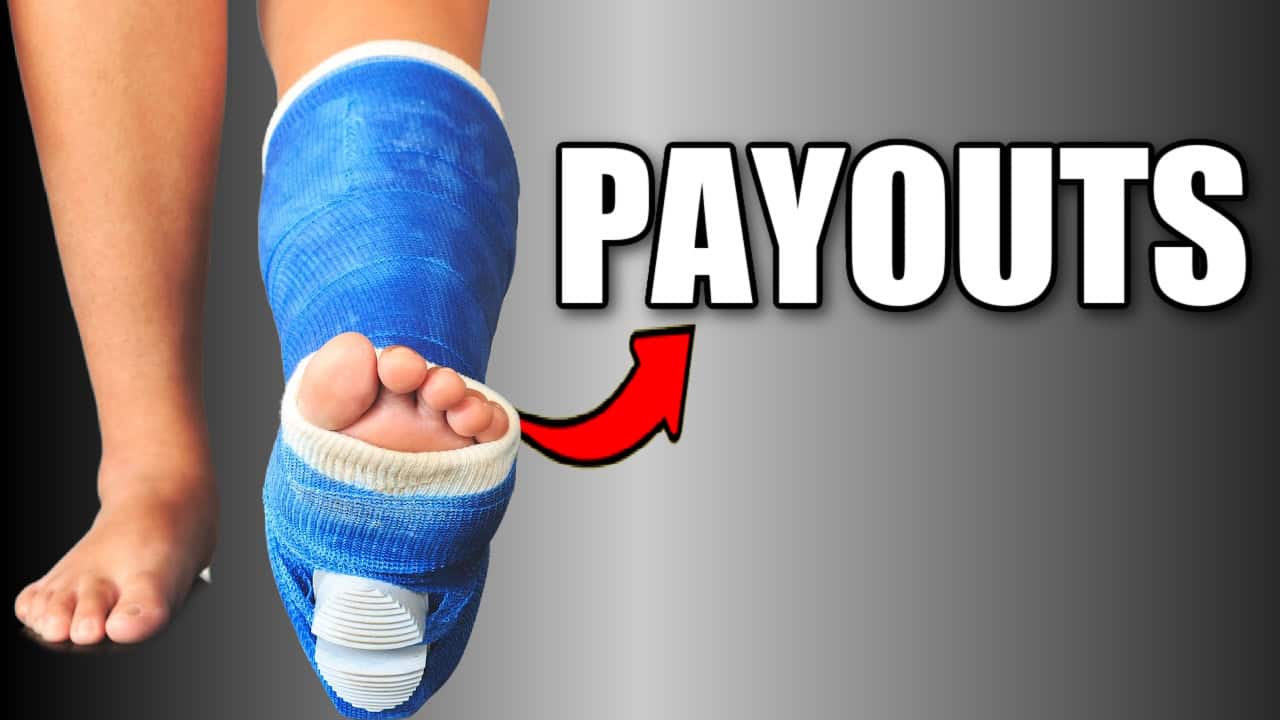
This is the complete guide to ankle injury claims and settlements.
In this in-depth guide you’ll learn:
- How much ankle injuries are worth
- Common mistakes that destroy your ankle injury claim
- How to increase your chances at getting a bigger ankle injury settlement
- Lots more.
So if you’re ready to become an expert at ankle injury claims, this guide is for you.
Let’s dive right in.
Table of contents
- What is the Value of Pain and Suffering in an Ankle Fracture Case?
- Which end of the pain and suffering range applies to your ankle fracture ( without surgery)?
- You Need a Lawyer Now More Than Ever
- How a Blood Clot Affects The Value of Your Ankle Fracture
- How much is a Single Bone Ankle Fracture with Surgery Worth?
- How Much is a Bimalleolar and Trimalleolar Ankle Fractures With Surgery Worth?
- Woman Gets $670,000 Settlement for Broken Ankle and 2 Surgeries
- Ask the Doctor if You’ll Need an Ankle Fusion in the Future
- How Much is a A Bimalleolar Fracture with Surgery, and a Recommended Ankle Fusion Worth?
- $350,000 Settlement for a Broken Ankle (Car Hit Bike Rider)
- Woman’s $100K Victory in Ankle Injury Case
- $90K Settlement for Broken Ankle (Pedestrian Hit by Car)
- $30K Settlement for Broken Ankle (Trip and Fall)
- Lady Gets $25K Settlement for Ankle Fracture from Slip and Fall
- Target Shopper Gets $60K for Ankle Fracture
- Jury Awards Only $7K for Ankle Fracture (from Fall)
- How Much Is a Trimalleolar Ankle Fracture Worth?
- How Does a 2nd Surgery to Remove Hardware Affect a Trimalleolar Case Value?
- $667K Verdict for Trimalleolar Ankle Fracture (With Surgery)
- $1.63 Million for Trimalleolar Fracture from Fall at Wendy’s
- $75,200 Verdict for Ankle Fracture from Slip and Fall
- Settlements for Tibia and Fibula Fractures in Children
- Which Accidents (that Cause an Ankle Fracture) Result in the Biggest Settlements?
- Which Doctors Won’t Kill an Ankle Fracture Case?
- Miami-Dade County Foot and Ankle Doctors
- Broward County Foot and Ankle Doctors
- Anatomy of the Ankle
- Documenting Your Ankle Injury
- How Your Doctor Visits Affect Your Case
- How Treatment for a Lateral Malleolus Fracture Affects Your Case
- Did You Break Your Ankle in an Accident in Florida?
Different Ankle Injuries have Unique Case Values
A fractured ankle can be just a simple break in one bone. It may not even prevent you from walking. With a simple break in one bone, the case has a lower value.
On the other hand, you may have several fractures that make your ankle out of place and prevent you from placing weight on it for a couple of months or so. If you have several fractures, your case has a higher full value for settlement purposes.
This is, in part, because not being able to put weight on your ankle affects your quality of life. It becomes part of your claim for loss of enjoyment of life.
The greater the number of bones that are fractured, the more unstable your ankle is. The full value of your case increases if your ankle is unstable.
It’s possible to damage ligaments in addition to your ankle fracture. The ligaments in your ankle hold the ankle bones and joint in place.
Your case is stronger if you’re an active person who suffers an ankle fracture. This is because an active person’s life is more greatly impacted by being inactive due to a broken ankle.
What is the Value of Pain and Suffering in an Ankle Fracture Case?
If someone’s negligence causes you to break an ankle, you need to assign a certain value to the pain and suffering component of the case. Pain and suffering one of the damages that you can get compensation for. You need to know the pain and suffering value so that you can be in the best position to settle your case.
The bad news?
Ankle fractures (without surgery) usually have low values. The full settlement value of pain and suffering of a simple ankle fracture (without surgery) is over $25,000 or more.
This range is for cases in the Miami-Dade, Broward and Palm Beach County and other counties in Florida with liberal juries. On the other hand, in a conservative county, the range could is lower.
If you are an older person who breaks their ankle in an an accident, the pain and suffering is worth more because your ankle typically won’t heal perfectly.
What if you have a single bone ankle fracture (without surgery) and you are over 60 years old?
In this instance, an insurance company with bodily injury liability limits of $50,000 may pay the limits to settle the case.
This is especially true if you are dealing with a better paying insurer like The Hartford, Nationwide Insurance Company, Crum & Forster, Hanover and others.
However, when appropriate, you should look for additional insurance.
Companies like Progressive, Allstate and Farmers are more likely to value your pain and suffering at the lower end of the range. They are all really cheap.
Which end of the pain and suffering range applies to your ankle fracture (without surgery)?
The low end ($25,000) applies if your ankle fracture:
- Heals in a few weeks with a little bit of physical therapy (PT); and
- Has little to no permanent impairment (injury) or limitations.
A higher range applies if you have:
- A longer period of treatment (about one year or longer); and
- More serious future limitations on the use of your ankle; and
- Continuous serious pain
Keep in mind that the above pain and suffering values are full values for settlement purposes. In a car accident case, where the other driver is 100% at fault, you may get the full value.
On the other hand, you’ll rarely get full value in a slip and fall case. If the condition that you slipped or tripped on is open and obvious, you should discount the settlement value accordingly.
Issues proving liability and cases where you are greatly at fault can quickly lower the value of broken ankle case. They can reduce the value of a broken ankle case without surgery down to $20,000 or $10,000 (or maybe less).
You Need a Lawyer Now More Than Ever
In Florida, a new law says if you’re more than 50% at fault in an accident, you won’t get money. This isn’t just a minor change; it’s a game-changer that could leave you empty-handed if you’re not careful.
Imagine needing money for medical bills, fixing your car, or even just to get by—and getting zero because you’re more than 50% to blame. That’s why, now more than ever, you can’t afford to take risks.
You need a top-notch lawyer who can fight for you to tip those scales in your favor.
How a Blood Clot Affects The Value of Your Ankle Fracture

Florida jury verdicts typically put the full value of a pain and suffering for a blood clot between $50,000 and $75,000. This assumes that you take a blood thinner (like Coumadin or Xarelto), and the clot resolves without incident.
You then add the value of a blood clot to the value of the ankle fracture (and other injuries). That gets you to the full value of the case.
You then discount it by factors, if any, that may need to be considered.
How much is a Single Bone Ankle Fracture with Surgery Worth?
If you break one ankle bone, and a doctor puts a plate and screws in your ankle, the pure exposure value of pain and suffering is between $100,000 to $150,000. (But there’s an exception to this that I’ll talk about in a bit.)
This value is based on past Florida jury verdicts. It assumes that you don’t have any major issues like a permanent limp or that you need to walk with a cane.
A single ankle bone fracture is when you break your distal tibia (medial malleolus), or your distal fibula (lateral malleolus).
If you then have a second surgery because one or more screws is bothering you, the full value of both the first surgery and the screw removal surgery is between $150,000 to $200,000.
You then need to add your medical bills and lost wages to this amount. You then reduce this value by any issues with liability or your fault if those apply.
Here’s the exception:
If your leg bone fracture is treated with an intramedullary rod—a rod that spans the length of the bone—the full value of the pain and suffering component alone exceeds $200,000.
How Much is a Bimalleolar and Trimalleolar Ankle Fractures With Surgery Worth?
If you look at Florida jury verdicts, the full value of the pain and suffering component of a bimalleolar fracture with ORIF surgery is $250,000 to $350,000. ORIF surgery is where a surgeon drills a plate and screws in your ankle bones.
If you fractured both the tibia and fibula, you have a bimalleolar fracture. Juries (and insurance companies) usually give you more pain and suffering compensation for a bimalleolar fracture than for a simple ankle fracture. This is because, in part, a bimalleolar fracture it involves two fractured bones. (The image at the top of this article is a bimalleolar fracture.)
The same is true for trimalleolar ankle fractures with surgery.
Sometimes if you have a bimalleolar or trimalleolar ankle fracture case, the surgeon will drill rods into your leg and they exit your leg and are attached to an external device. This is called an external fixator.
If you have this surgery, it adds value to your case. On a later date, the surgeon will remove the external fixator and put a plate and screws inside your leg. For settlement calculation purposes, you treat these as two different surgeries.
I’ve settled a trimalleolar ankle fracture surgery cases for $670,000 and $350,000.
However, if you do jury verdict research, you’ll find verdicts that are lower and higher.
If you have a bimalleolar or trimalleolar fracture with ORIF surgery and then have another surgery to remove the plate and screws, and you have a fairly good result and major pain reduction the full value of pain and suffering for both surgeries is between $300,000 and $350,000.
But that’s not it. You should to ask your doctor if you will need an ankle fusion.
Woman Gets $670,000 Settlement for Broken Ankle and 2 Surgeries

Madeline parked her car at a store in Doral, a place in Miami-Dade County, Florida. (You can see her in the above photo with me.)
She went shopping and bought some tiles. When she got back to her car, she needed to make room in her trunk for the new stuff. So, Madeline tried to move things from the trunk to the back seat.
She stepped up on the grassy curb. While walking in the grass towards her rear car door, Madeline tripped and fell on something unstable.
She injured her ankle. Someone called 911 and paramedics took Madeline to the hospital.
She broke her ankle in three places, which is called a trimalleolar ankle fracture. At the hospital, a surgeon drilled a rods into her ankle.
Take a look:
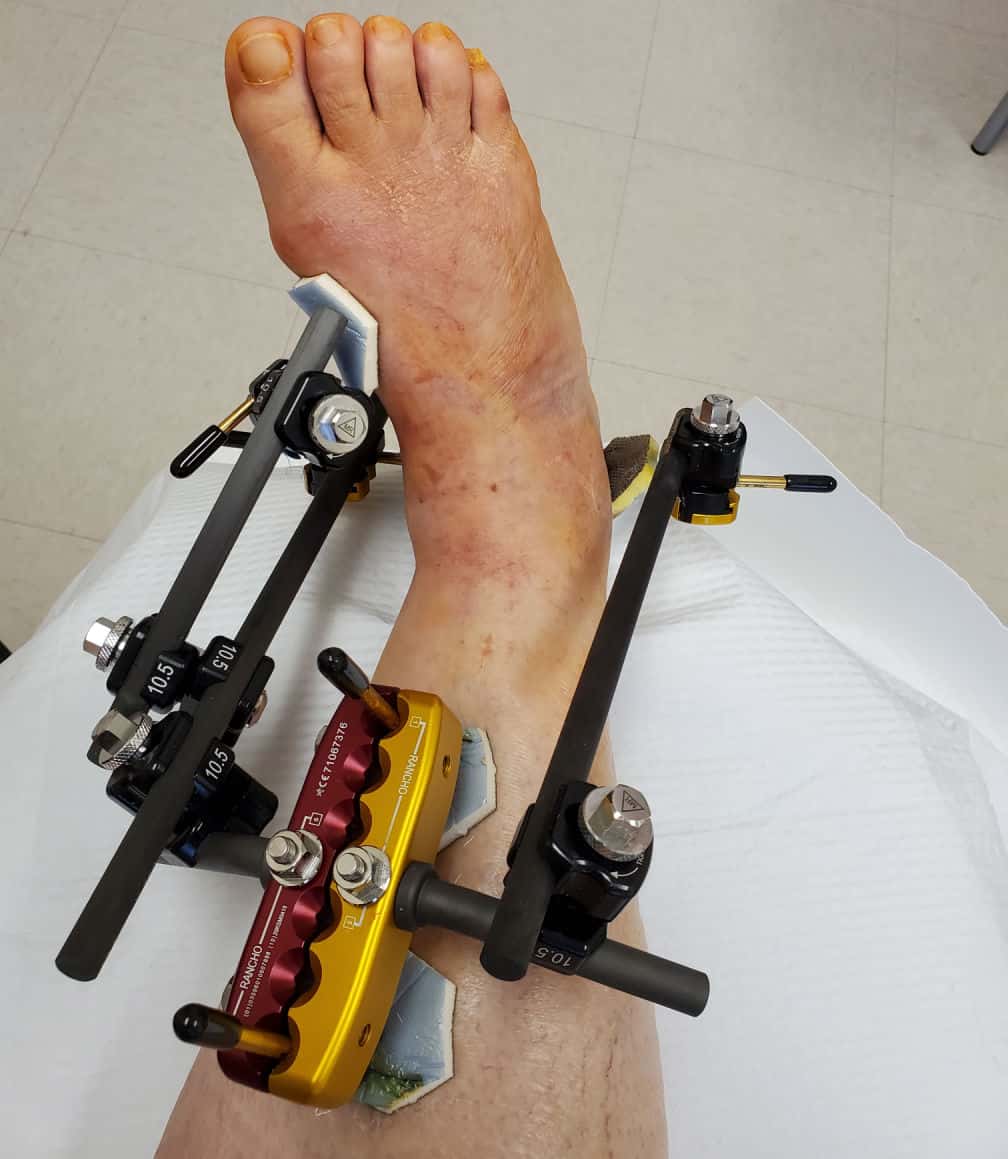
She got a free consultation from me to see if I could represent her. After we spoke, she hired me as her lawyer.
During a second surgery, a surgeon removed this device and drilled two plates and screws into her ankle.
While she was badly injured, her case was challenging.
Here’s one reason why her case was tough:
No one saw Madeline fall.
I requested the 911 audio. On the audio, Madeline said:
I tripped on something unstable in the grass.
Madeline on the 911 audio call
I sent this to the The Hartford, who insured both the landscaper and the parking lot owner.
A little less than 3 weeks after she fell, Madeline’s son took photos of both the grassy area.
I added arrows to show that the irrigation control valve didn’t have a cover on it. You can see the cover laying in the grass.
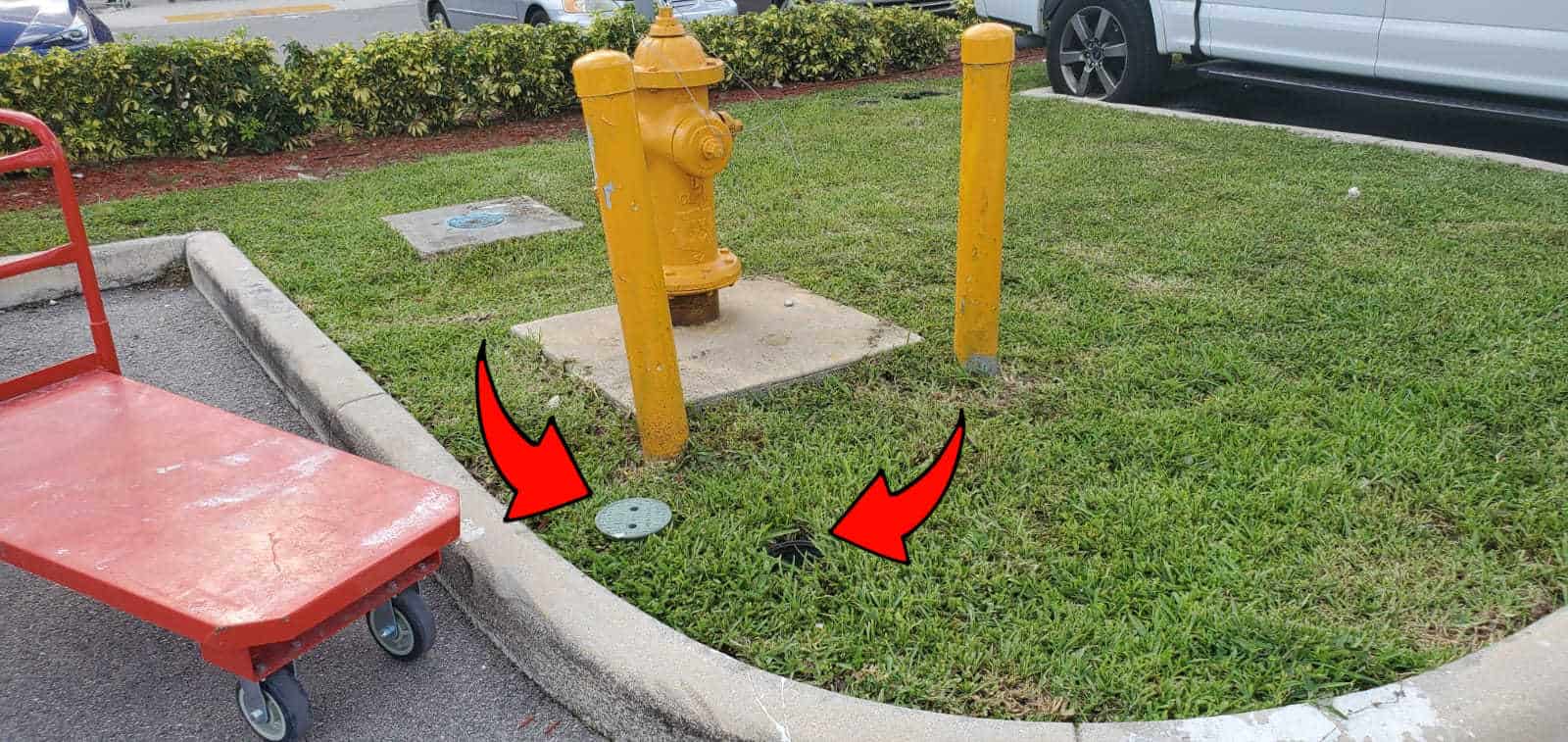
Pro Tip: After your accident, you should immediately take photos of the accident scene and hazard. Don’t wait. Property owners often fix hazards, and this can kill your case.
The Hartford (as the landscaper’s insurer) initially denied liability.
This video highlights common claim mistakes in ankle fracture cases, using Madeline’s experience as an example.
Madeline completed her medical treatment.
I spoke with her orthopedic surgeon to see if she developed arthritis and would need a future ankle surgery.
He said that while her ankle isn’t normal, she won’t need surgery in the future.
Even thought the Hartford denied liability as the landscaper’s insurer, I didn’t give up.
Insurance Company First Offer Was Only $131,514
The Hartford (as the landowner’s insurer) offered $131,514, which was way too little. Even good insurance companies like the Hartford are tough.
After an intense negotiation, I settled her case for a whopping $670,000!
The breakdown is:
The Hartford (as insurer for the landowner) paid $469,000. The settlement check (redacted) is below:

The Hartford (as insurer for the landscaper) paid an additional $201,000. Yes, they paid $201,000 even after they initially denied liability!
It gets better:
I also got the Hartford to issue checks for $15,000 in Medical Payments benefits. This will significantly cut down on the amount that we need to pay back her health insurance company.
But it doesn’t stop here.
I don’t charge a fee on this $15,000 in Medpay benefits since we didn’t sue.
Here’s a tip that may save you big bucks:
Before hiring a lawyer, get them to confirm that they won’t charge a fee on Medpay benefits if they don’t sue.
After my lawyer fees, costs and her medical expenses, Madeline got over $342,750 in her pocket. As you can imagine, she is very happy with her settlement.
In fact, she already referred me someone who was seriously injured in an accident.
Ask the Doctor if You’ll Need an Ankle Fusion in the Future
If your orthopedic doctor says that you will need a future ankle fusion, the full value of the pain and suffering component of the fusion could be $200,000 or higher.
In order to convince an insurance adjuster that you’ll need an ankle fusion, you typically need:
- Continued medical treatment and problems after your ORIF surgery
- Evidence of Post traumatic arthritis

If you don’t meet the above two criteria, it will be tough to convince the insurance company that you will need a fusion. Thus, they likely won’t offer you money for the future possible fusion.
If your ankle heals great or you haven’t received medical treatment for years before the time when the case is ready to settle, the insurance company likely won’t offer you money for your recommended ankle fusion.
Even if your doctor says that you need a future ankle fusion, the insurance company for the at fault party will likely argue that you do not need an ankle fusion. They will argue (or hire a orthopedic doctor) that medical peer reviewed research says that the likelihood of needing an ankle fusion is only about 2% to 3%. That is a small chance.
So don’t expect an insurance company to pay 100% of a future ankle fusion.
If you have diabetes, you’re more likely to need a second surgery. OTA International: December 2019 – Volume 2 – Issue 4 – p e042
Open ankle fractures are associated with complications and reoperations.
If you’ve already had an open reduction and internal fixation (ORIF) surgery for an ankle fracture, you are the most likely to need another operation within 5 years for end-stage arthritis if you have complicated diabetes. J Bone Joint Surg Am 2009 May; 91(5):1042-9. doi: 10.2106/JBJS.H.00653.
This doesn’t mean that you will need this second operation. It just means that people with complicated diabetes who have an ORIF surgery to their ankle are more likely than others to need a reoperation. This probably occurs due to increased risk of inadequate soft-tissue and fracture healing after surgery in diabetic patients.
When are you most likely to need a future ankle fusion or replacement surgery for the treatment of arthritis?
If you had an open ankle fracture, you have a higher risk of needing a ankle fusion or replacement surgery for the treatment of arthritis. An open fracture is where the bone breaks the skin. Thus, open ankle fractures are usually worth more than closed ankle fractures.
How Much is a A Bimalleolar Fracture with Surgery, and a Recommended Ankle Fusion Worth?
If you have surgery to fix a bimalleolar fracture, and the orthopedic doctor recommends an ankle fusion, the full value of the pain and suffering component may be $500,000 to over $1,000,000. Some verdicts are lower. Other verdicts may be higher.
$350,000 Settlement for a Broken Ankle (Car Hit Bike Rider)
Sam (not real name) was riding his bike in South Florida.
At the same time, Joe (not real name) was in his car heading north.
Joe was turning to go Eastbound.
While Sam rode his bike westbound in the crosswalk crossing, Joe accidentally hit him with his car.
You can see a crash diagram below:

As a result of the car hitting him, Sam broke 3 bones in his ankle.
You can see his broken distal fibula here:
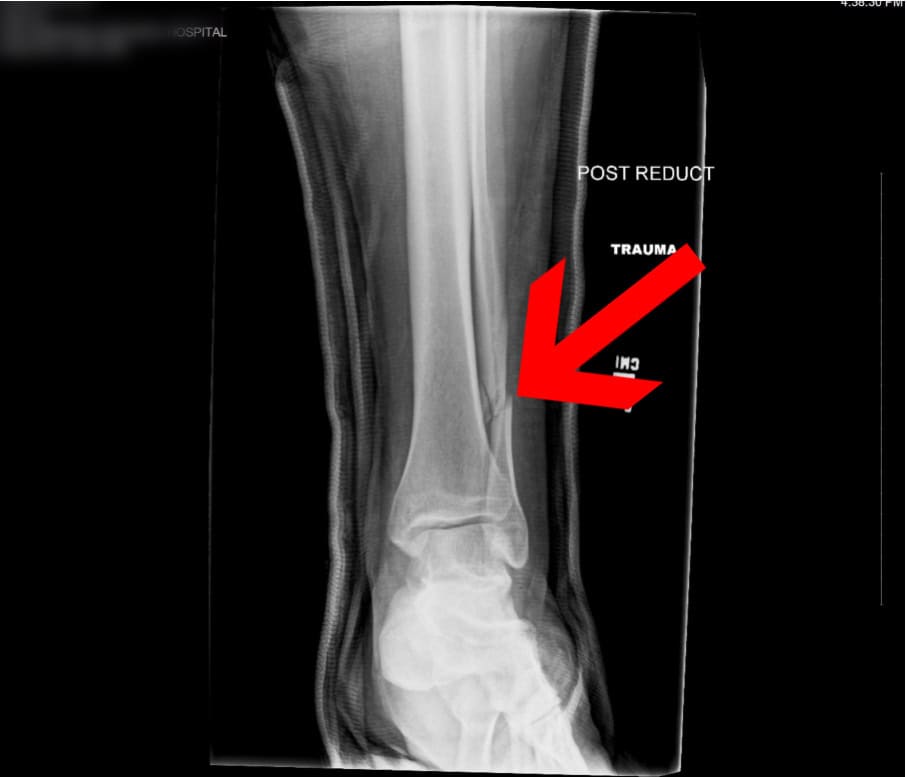
At the hospital, a doctor drilled screws into a plate in Sam’s ankle.
You can see a photo that the doctor took during the surgery:
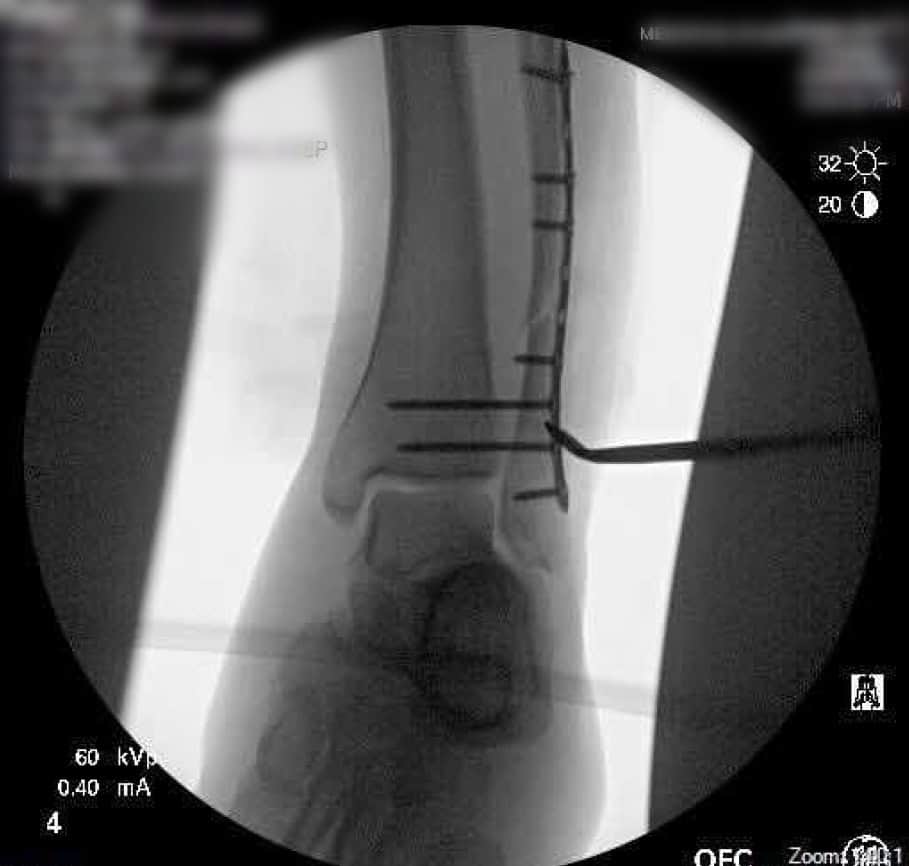
After he left the hospital, Sam searched for a South Florida lawyer who had experience in getting compensation for people who had broken a ankle in an accident. He found me.
Sam called my office and I gave him a free consultation. Shortly after we spoke, Sam hired me.
I told Sam to take a photo of his incision after the first surgery.
This image shows the raised incision site after surgery:
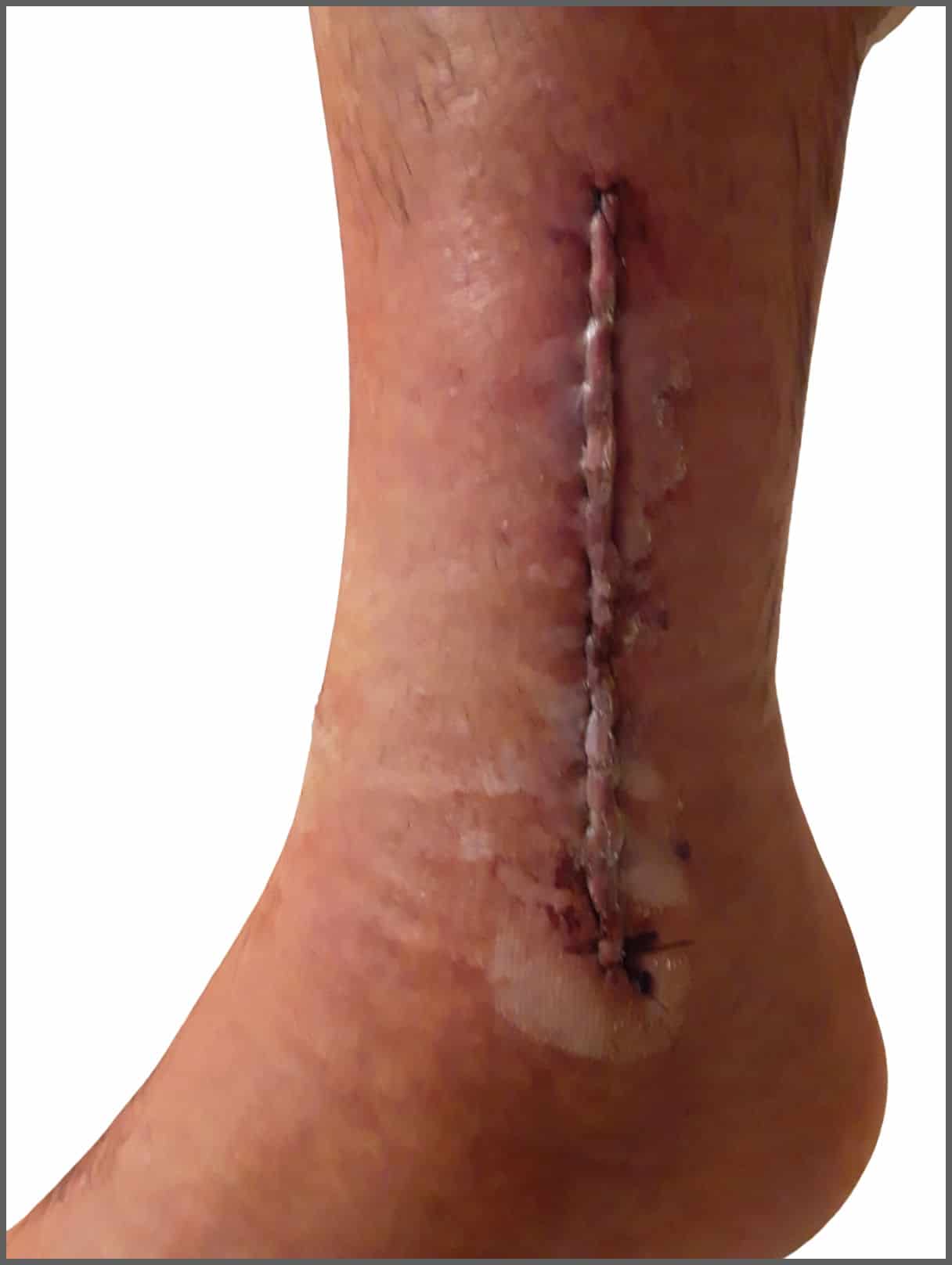
Below you can see the size of the incision needed for the surgery.
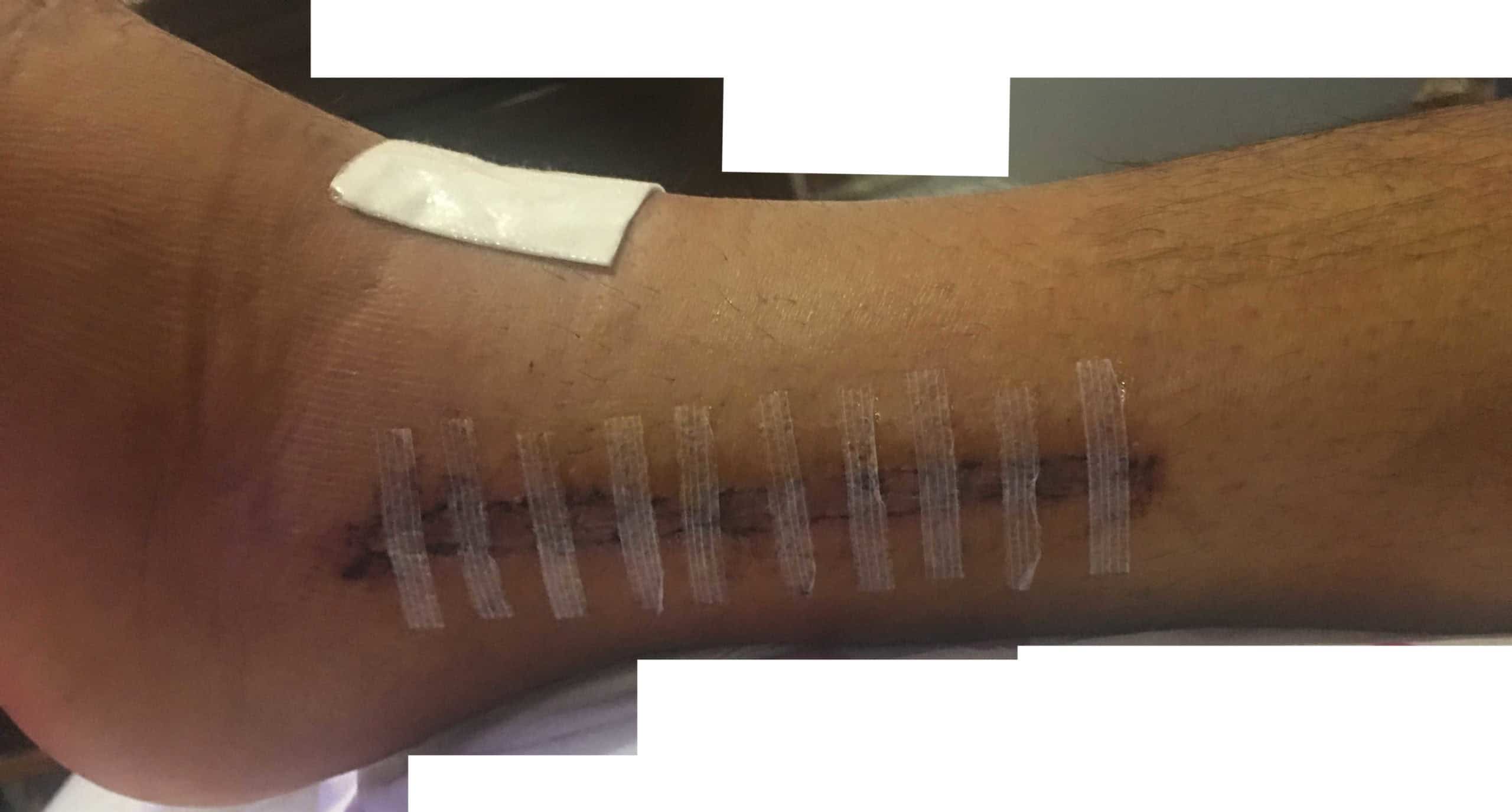
GEICO insured the Joe (the driver of the car). We found out that Joe had a $300,000 in insurance (bodily injury liability coverage). Joe also had an umbrella policy.
We requested the 911 audio call from the county. In the 911 call audio, you can hear Sam at the scene screaming in pain after being hit by GEICO’s insured.
Additionally, in the 911 call the driver (Joe) states that he hit someone on a bike. At some point, I may add the audio from the 911 call here.
GEICO Paid for the Driver’s Lawyer
The GEICO adjuster (Myrna Rivera) paid for a defense lawyer to represent Joe and the owner of the car. Myrna said that she hired a lawyer because I asked the driver and owner of the car to preserve his car.
I also asked the driver to preserve the “black box” that may have shown the speed of the impact. I spoke with an event data recorder download specialist who said that the impact likely was not captured if there was little damage to the car.
Sam went to several physical therapy visits.
Sam went to a few visits with his orthopedic doctor. Due to his complaints of pain and swelling in his ankle, his surgeon decided to remove the plate and screws from his ankle. The doctor did the surgery at the hospital, where Sam spent two days.
You can see the cast that his doctor put on his ankle:
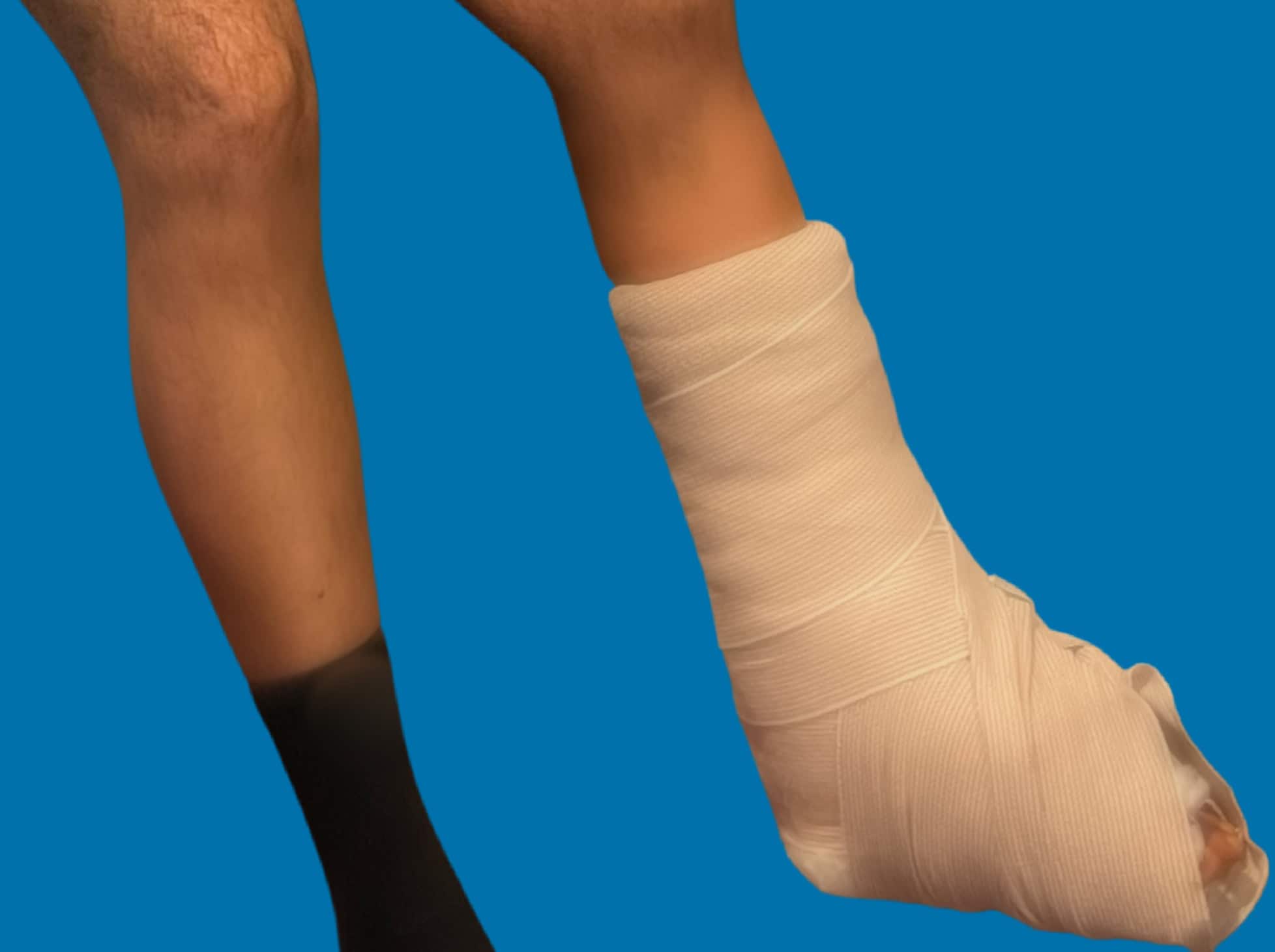
The following photo was taken after Sam’ second surgery.
It again shows the size of the incision and scar.
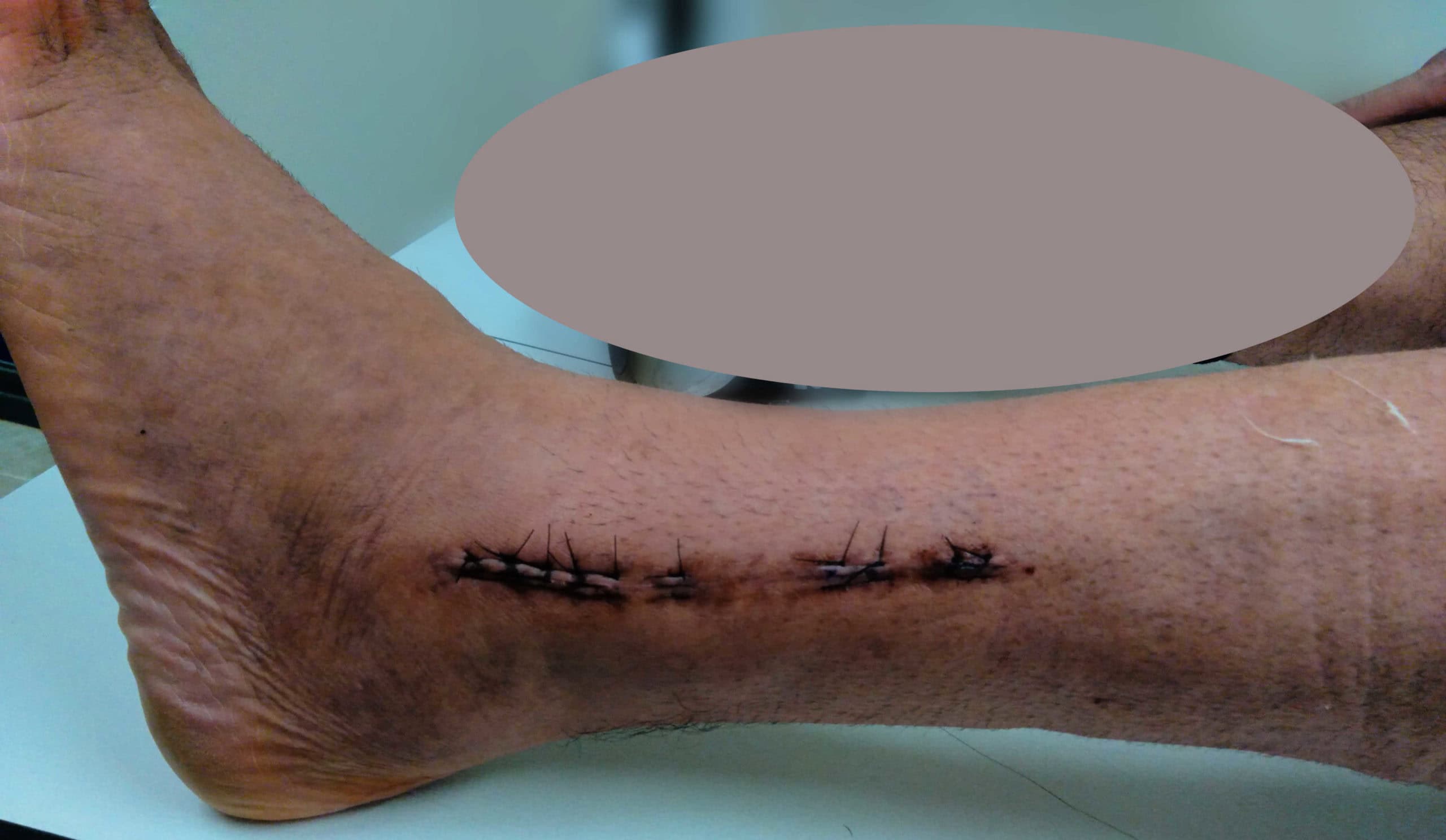
Sam went to a few more visits to his orthopedic surgeon.
A few months after the 2nd surgery, he went to the hospital complaining of leg swelling.
Sam still complained of pain in his ankle. His doctor did not know what was causing this pain. He said that the only thing he thought it could be was chronic regional pain syndrome (CRPS). However, the doctor said that he did not have the usual symptoms of CRPS.
Sam’s surgeon stated was not an expert in CRPS. Thus, he referred him to a pain management doctor.
The pain management doctor reviewed a bone scan and said that the results did not show CRPS and his exam was not completely consistent with CRPS. However, Sam showed the doctor photos of his ankle and the doctor said that it was consistent with complex regional pain syndrome. The pain management doctor referred Sam to doctors who specialized in his CRPS.
Sam did not own a car at the time of the accident. He lived with a relative whose PIP insurance paid $10,000.00 to his medical providers.
The total medical billed charges were about $186,000. Most of these billed charges were from the hospital visits. However, this is not that amount that Sam’s Medicaid paid the providers.
Sam had Medicaid, a Medicaid HMO and another temporary assistance program. They paid under 6,400 to the hospital and his doctors. And the hospitals and doctors adjusted (reduced) the bills to zero.
In other words, Sam did not owe the hospital or doctors any money. (As you’ll see in a moment, we had to payback Medicaid, Medicaid HMO and the assistance program back from the settlement after I took my lawyer fees and costs.)
GEICO Offered Much Less than a Trimalleolar Ankle Fracture (With Surgery) is Worth
GEICO offered just $100,000 to settle Sam’s car accident injury claim. The defense lawyer said that the offer was fair. I know that just the full value of pain and suffering of a broken ankle with two surgeries is worth much more than $100,000. And that’s not even adding in the fact we had to pay back Medicaid.
Thus, we told Sam to reject it and he did so.
In 2021, GEICO paid us $350,000 to settle Sam’s personal injury claim.
This chart shows a comparison between the first offer and the settlement.
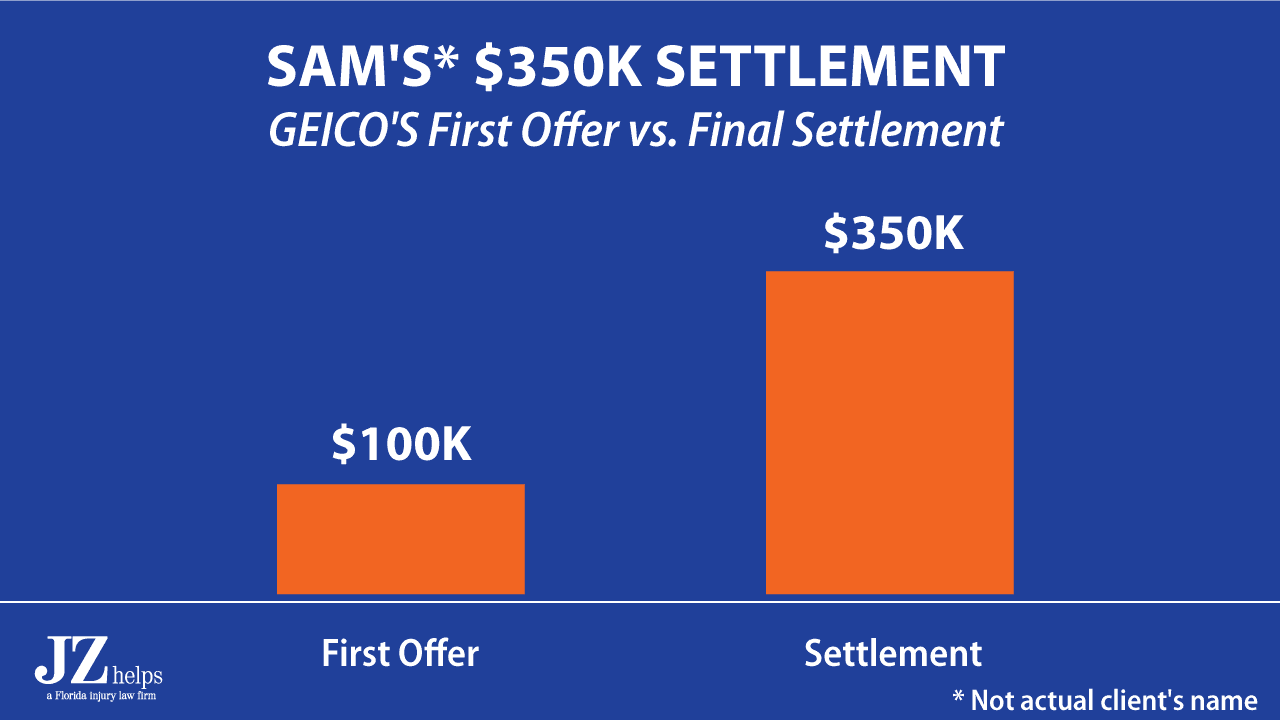
About $343,642 of the $350,000 settlement was for pain and suffering. The rest of the settlement is for the Medicaid and other liens that we had to pay back.
This chart that shows the settlement breakdown between medical bills/liens that we had to pay back, and pain and suffering:
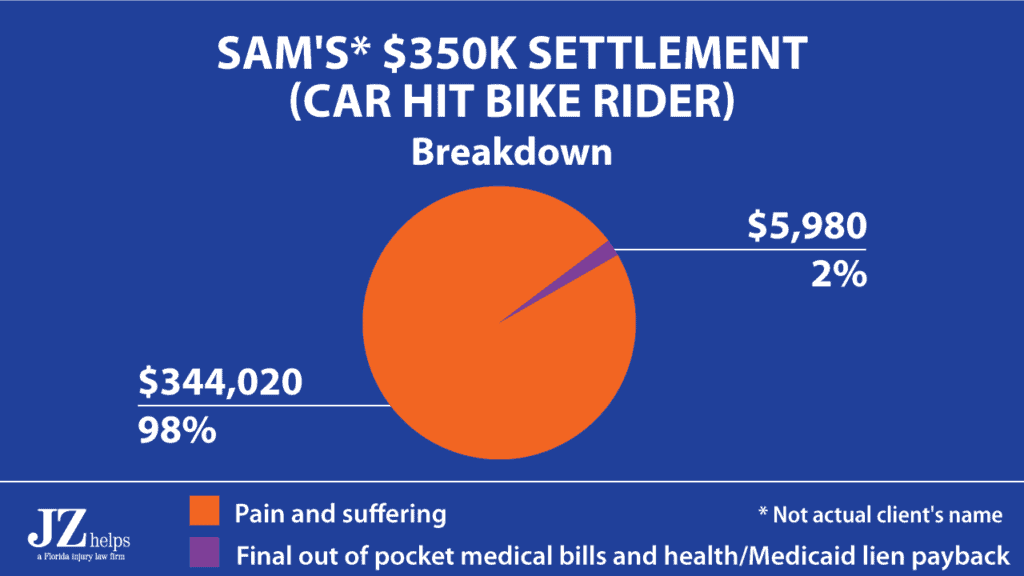
After my attorney fees and costs, and paying back the Medicaid liens, Sam got $226,818 of the settlement in his pocket.
Take a look:
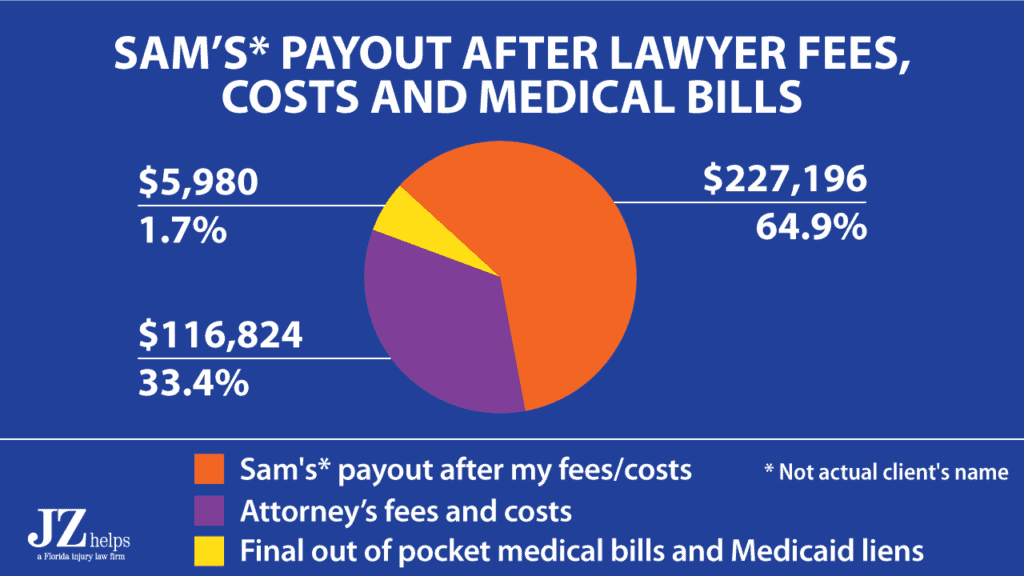
The $350,000 settlement was about 55 times the Medicaid lien and other liens that we had to pay back.
Check out the pain and suffering multiplier below:
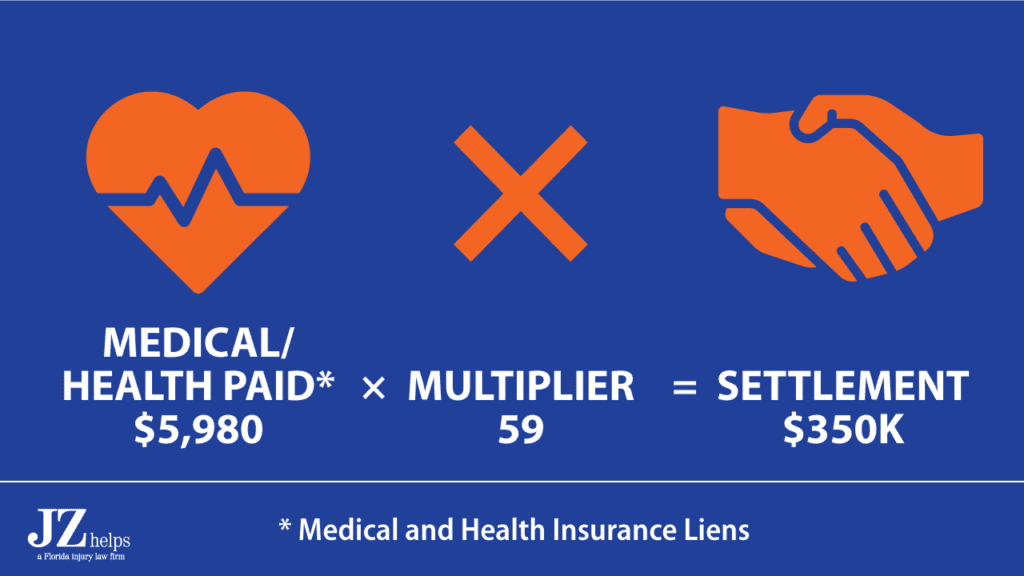
You can see the $300,000 check (redacted) for compensation for Sam’s broken ankle.

They also sent us a $50,000 settlement check from the driver’s personal umbrella insurance policy.
Below, you can see the redacted $50,000 check for compensation for Sam’s broken ankle:
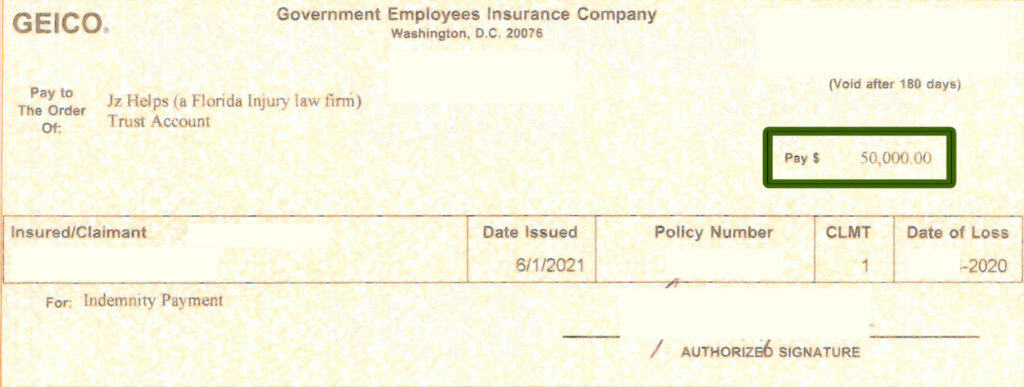
Woman’s $100K Victory in Ankle Injury Case
Misty was in Miramar Beach, Florida, visiting friends at a condo. They all went to the beach, walking on the boardwalk.
After a fun day at the beach, they used the boardwalk to go back. This time, Misty was walking the other way, heading home from the beach.
She was carrying beach chairs and a football when she tripped on a piece of wood sticking up on the boardwalk.
She fell down and felt a really bad pain in her ankle. She couldn’t stand up.
Someone called 911, and the paramedics came fast to help her.
As Misty was lying there hurting, she overheard the security guard talking about the sticking-up wood being a problem before. We’ll talk more about this soon.
The ambulance took Misty to the hospital. The doctors there said her ankle was broken and she needed an operation.
The Harsh Reality: A Broken Ankle and Rising Bills
Misty started to worry about the big hospital and doctor bills. She didn’t want to be stuck with all that cost.
She thought about getting a lawyer to help her, but was worried about the lawyer’s fees.
So, she went online to find lawyers who had a strong reputation for securing large settlements in broken ankle cases, especially those involving accidents at condominium associations.
That’s when she found me. We talked for free, and I told her she wouldn’t owe me anything unless I won her case and got her a settlement. This news really helped calm her down.
Misty decided to hire me, and I got right to work to protect her rights.
I showed exactly where the boardwalk was raised, so you can see the problem.
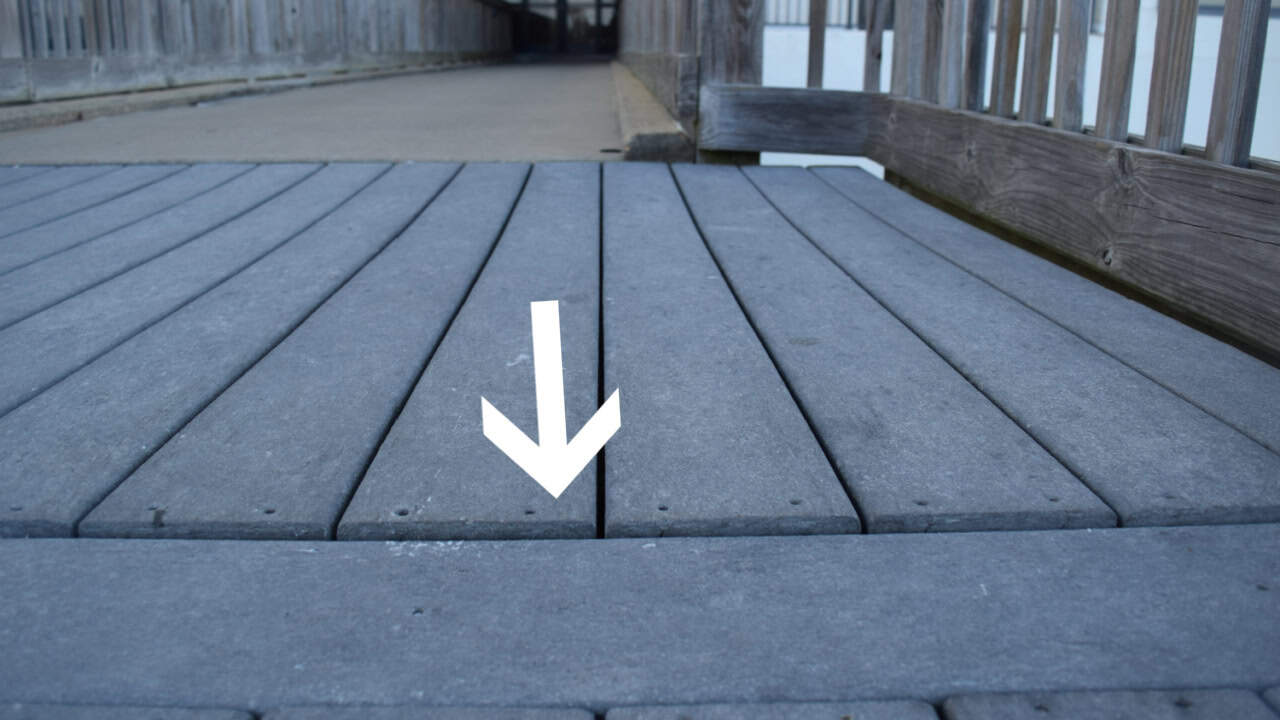
The First Step in a Challenging Journey
Right after Misty chose me as her lawyer, I didn’t waste any time. I sent a letter to the condo association and the property manager, making sure they didn’t change anything where Misty fell. It was the first move in what would be a tough battle.
Dealing with a Tough Insurance Company
The condo’s insurance was through Global Indemnity Group. They’re known for being really tough and not wanting to pay much.
Enormous Power Tip
In cases where you trip and fall, it’s better if the thing you tripped on is higher than half an inch. Little details like this are super important.
Racing Against Time
Then, the insurance company said the condo association was going to fix the boardwalk where Misty fell. We had to move fast.
Why Having a Lawyer Massively Helps
I hired an engineer for almost $2,500 to help us, but Misty didn’t have to pay this right away. That’s one massive benefit to having a lawyer.
Our engineer took a lot of photos – 211 in total – to show everything about where Misty fell.
Fighting Hard in Negotiations
I met with the insurance claims representative myself. We talked a lot, and it was a tough conversation, but we didn’t give up.
Winning the Case Big
Finally, all our hard work paid off. We got a settlement from the insurance for $100,000.
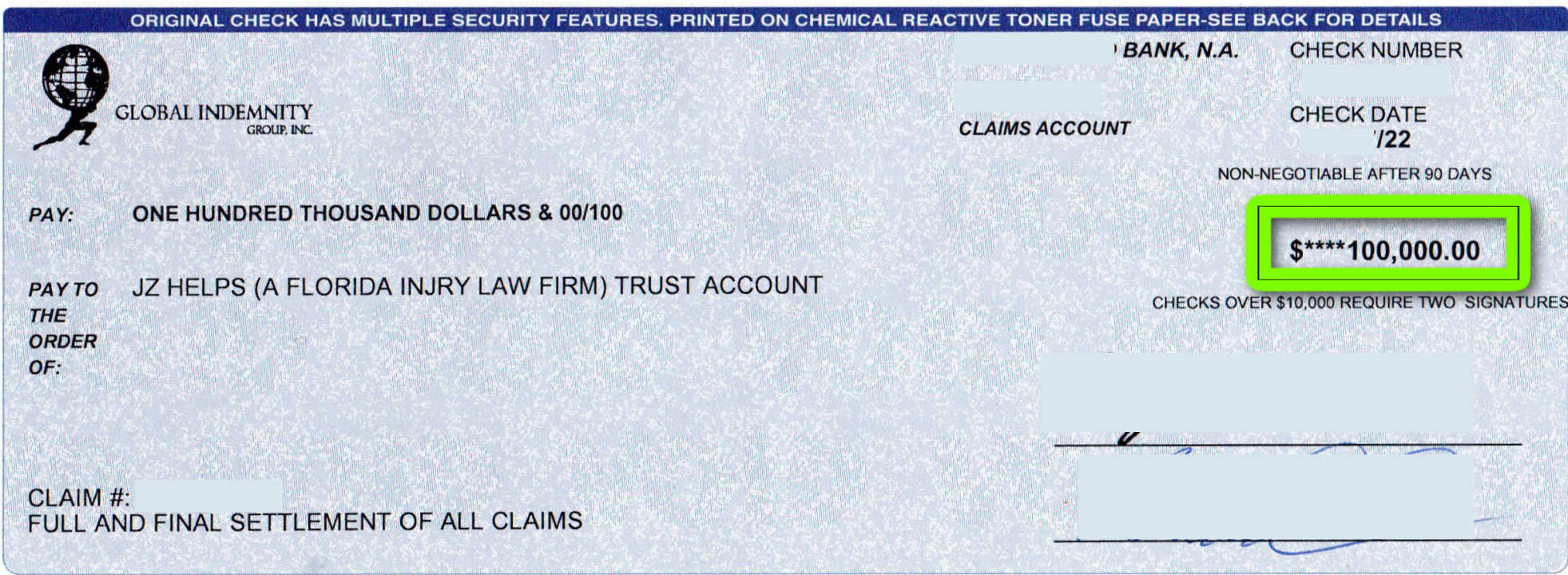
After we took care of the legal fees and medical bills, Misty got over $59,771 for herself.
Misty was thrilled with the settlement. She gave my law firm this review:
5 star review on Google MapsNo one wants to be involved in a personal injury case, but if you are this is the firm you need to hire.
Justin and Jenny [paralegal] are just incredible to work with, they keep you informed every step of the way.
They make you feel like you are their top priority. Justin will fight for what is fair and deserving in your case from start to finish!
He is amazing!
$90K Settlement for Broken Ankle (Pedestrian Hit by Car)
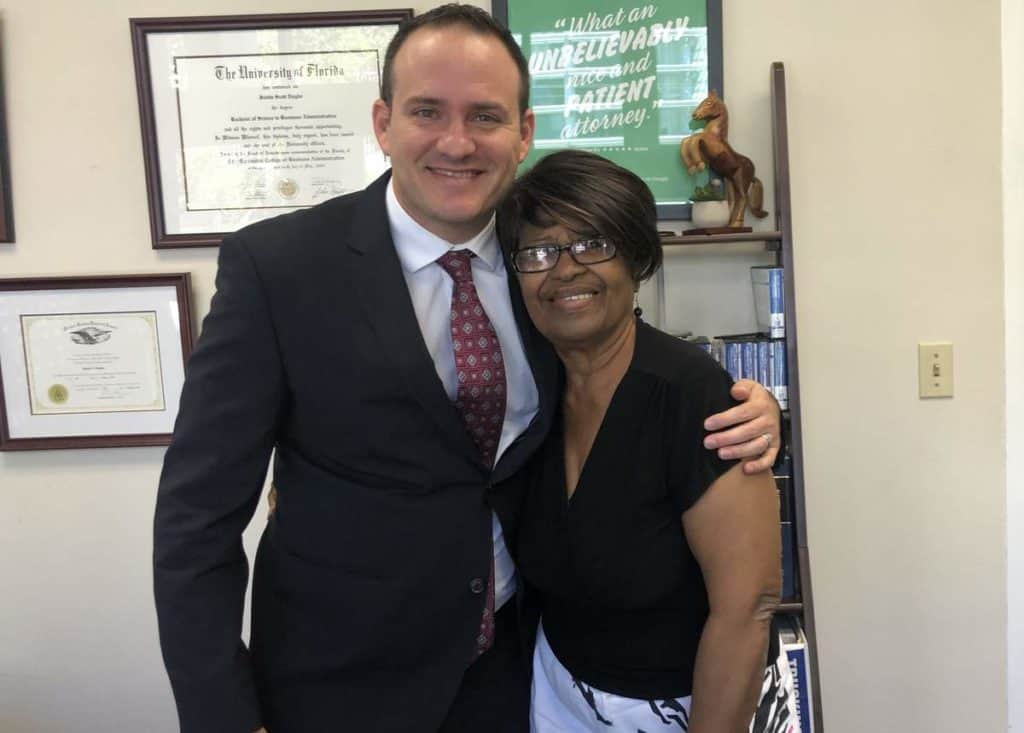
During broad daylight, Alice was walking in a supermarket parking lot in North Miami, Florida. A car struck her.
Here is the diagram from the Florida traffic crash report:
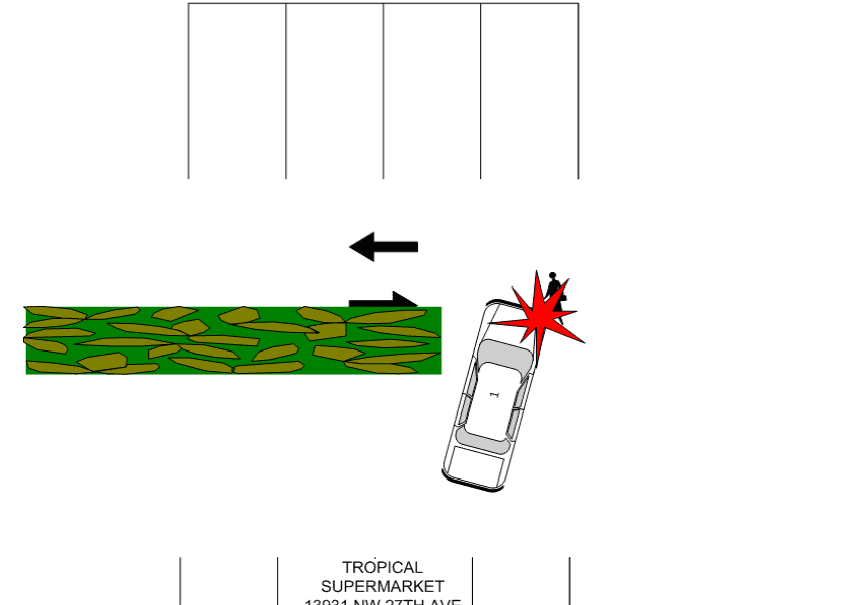
Here is a street view of the accident scene:
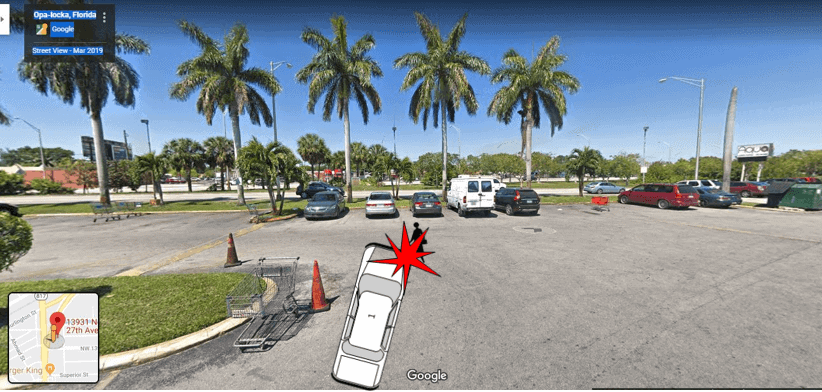
As a result, Alice broke her ankle (distal fibula). Fortunately, she did not need surgery. As with all fractured ankle cases, surgery would have increased the full settlement value of the case. Full value is the amount before reducing case value by difficulty proving liability and other potential issues.
Alice also bruised her face as a result of it impacting the road.
Alice’s granddaughter searched for a pedestrian accident lawyer in Miami. She called me for a free consultation to see if I could represent her grandma.
After hearing the basic facts of the case, I told her that I believed that I could represent her grandma. However, ethically, her grandmother had to call me. She then had Alice call me. After we spoke, she quickly hired me. I immediately began fighting for her rights.
Progressive insured the driver who hit her. And they took a tough stance. Progressive blamed Alice (at least partially) for getting hit by the car!
I jumped into action and argued that the driver had plenty of time to see Alice. This was particularly true because the accident happened in broad daylight. You see, the time of day when the accident happened can affect the settlement value of a pedestrian’s case.
I also told Progressive that there was nothing obstructing the driver’s view. Ultimately, we settled Alice’s personal injury claim for $90,000.
94% of the Settlement was for Her Pain and Suffering
Most of the settlement was for her pain and suffering. Here is a pie chart which shows the breakdown:
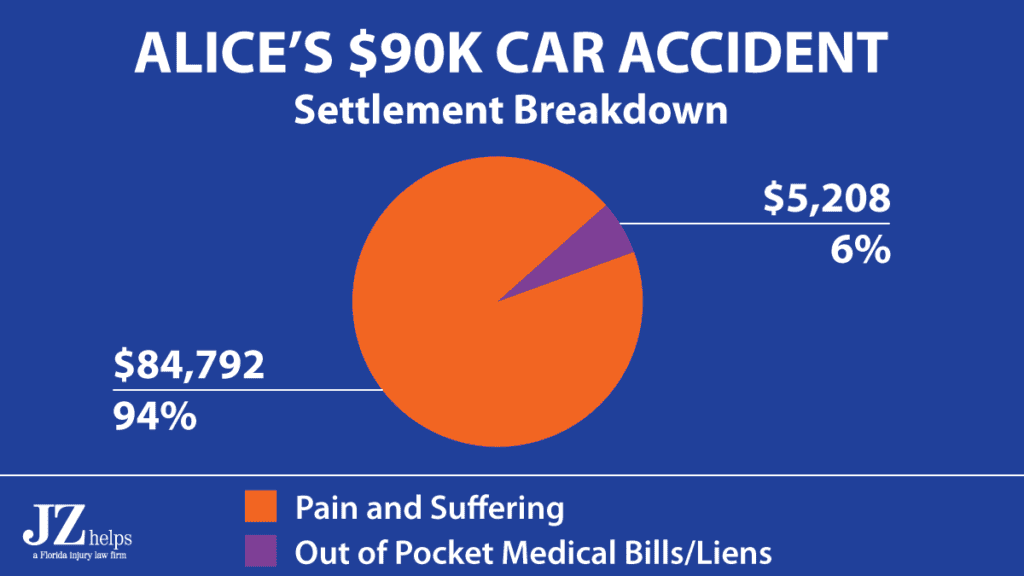
Just 6% of the settlement was for her medical bills. She owed very little in out of pocket medical bills. This is because her personal injury protection (PIP) from her car insurance paid most of her medical bills.
Alice was entitled to PIP benefits because she owned a car at the time of this accident. United Auto Insurance Company (UAIC) insured her car.
Additionally, she had a Medicare supplement insurance that paid for some of her bills. Check out the Progressive settlement check:

The best part?
Alice is thrilled with the settlement. This is one of my many car accident settlements with Progressive. Here, Alice broke the distal fibula (which forms the ankle.) You can learn about settlements that also include other parts of the lower leg (fibula and/or tibia).
$30K Settlement for Broken Ankle (Trip and Fall)
Dawn went to a wildlife safari park in Osceola County, Florida. During broad daylight, she claimed that she rolled her ankle and fell on a broken walkway.
You can see a photo that shows the general area of the cracked pavement:
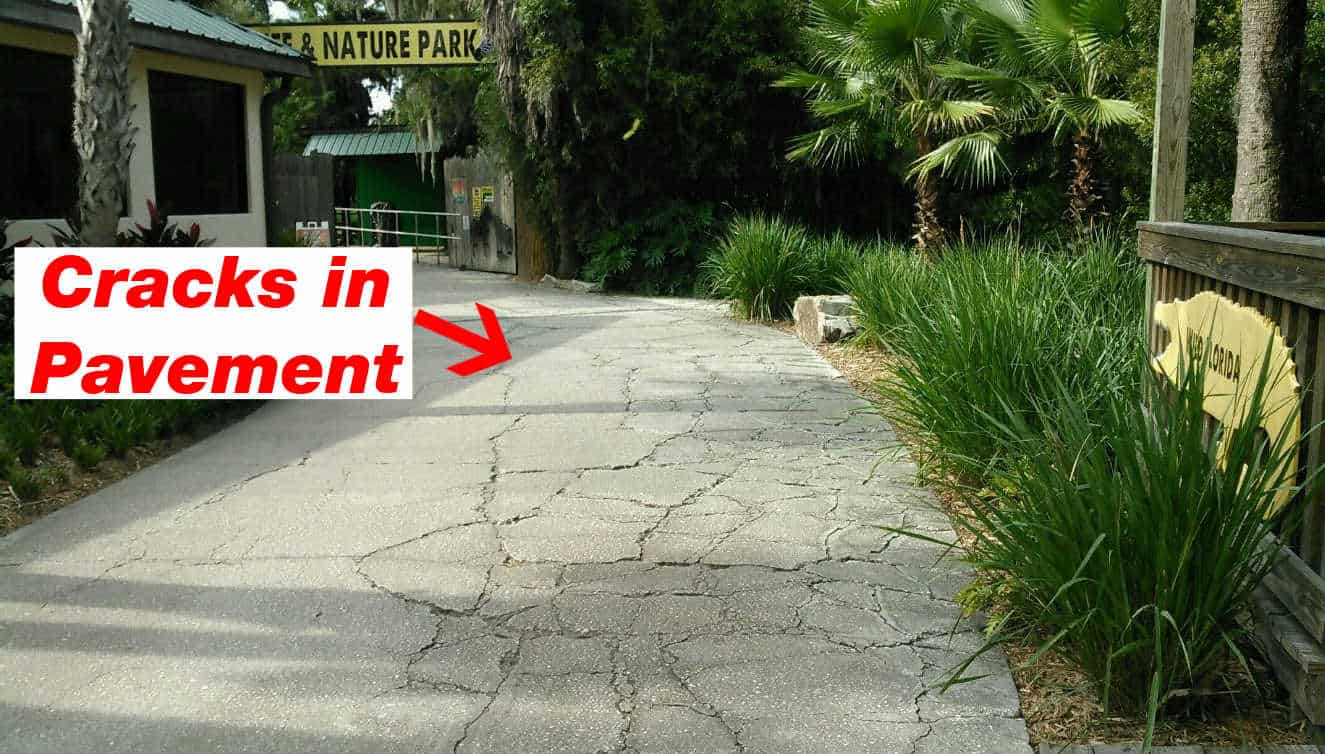
An employee of the establishment came to the accident scene while Dawn was on the pavement.
They asked her some questions.
Dawn went to the hospital, where x-rays showed that she had a broken ankle. Specifically, she had a non-displaced right lateral malleolus fracture. She was at the hospital for a few hours.
She wanted to hire an injury lawyer. She looked on Youtube for an trip and fall injury attorney who had good outcomes. She watched some of my videos and called me for a free consultation to see if I could represent her.
I personally spoke with her and she hired me.
I asked my client to lawfully take a photo that showed the measurement of the depth and width of the crack in the pavement that claimed caused her ankle to roll. I told her to use measuring tape, a deck of cards or a stack of pennies.
She had this photo taken, which showed a penny in one of the cracks.
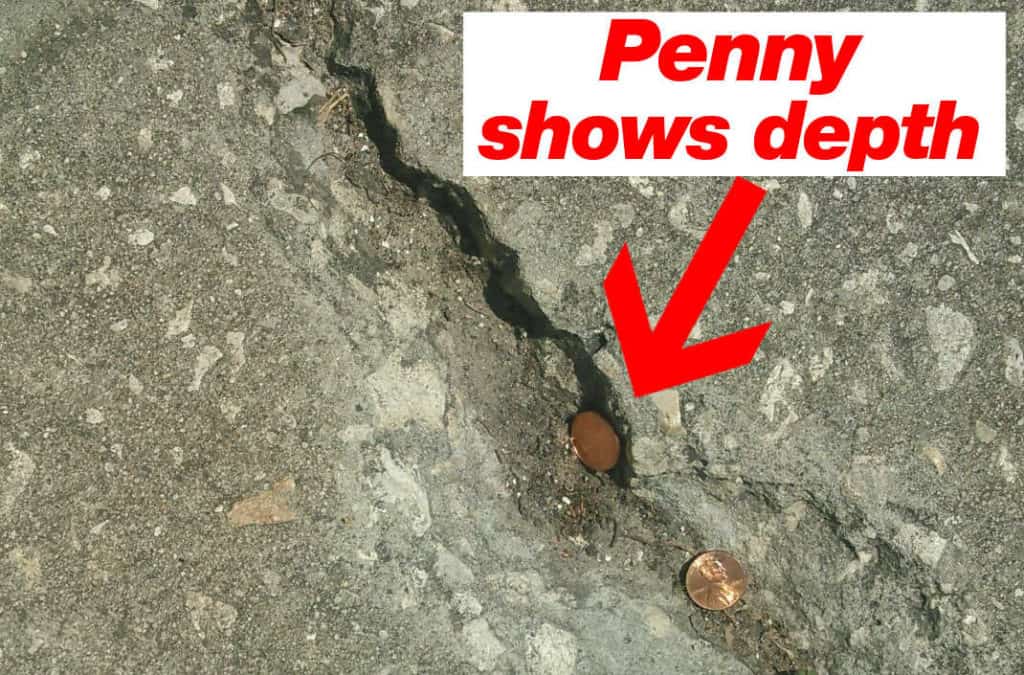
In the following months, she received treatment for her broken ankle from an orthopedic doctor.
I asked Dawn to take a photo showing the walking boot that the doctor prescribed for her to wear.
You can see Dawn with a walking boot on her foot:
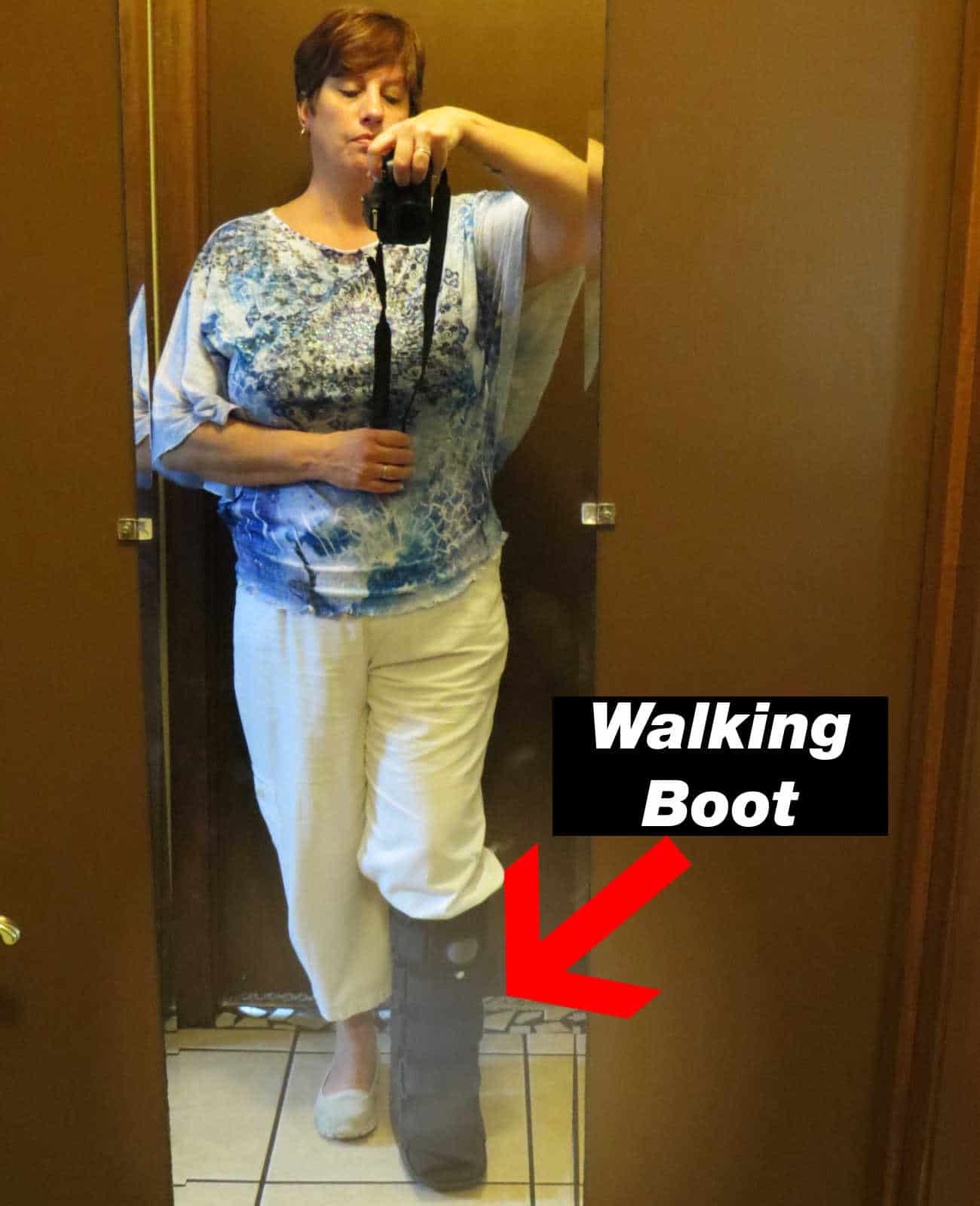
I sent this photo to the insurance adjuster.
Fortunately, Dawn did not need surgery. Her ankle made a very good recovery.
National Casualty Company insured the owner of the premises. K&K Insurance Group handled the claim for National Casualty Company. National Casualty Company is part of Scottsdale Insurance Company. Scottsdale is part of Nationwide Insurance Company.
K & K Insurance Group argued that Dawn was partially at fault for not avoiding the walkway since they said it was open and obvious. Their first offer to me was $5,000 to settle Dawn’s injury claim.
Here is the email:
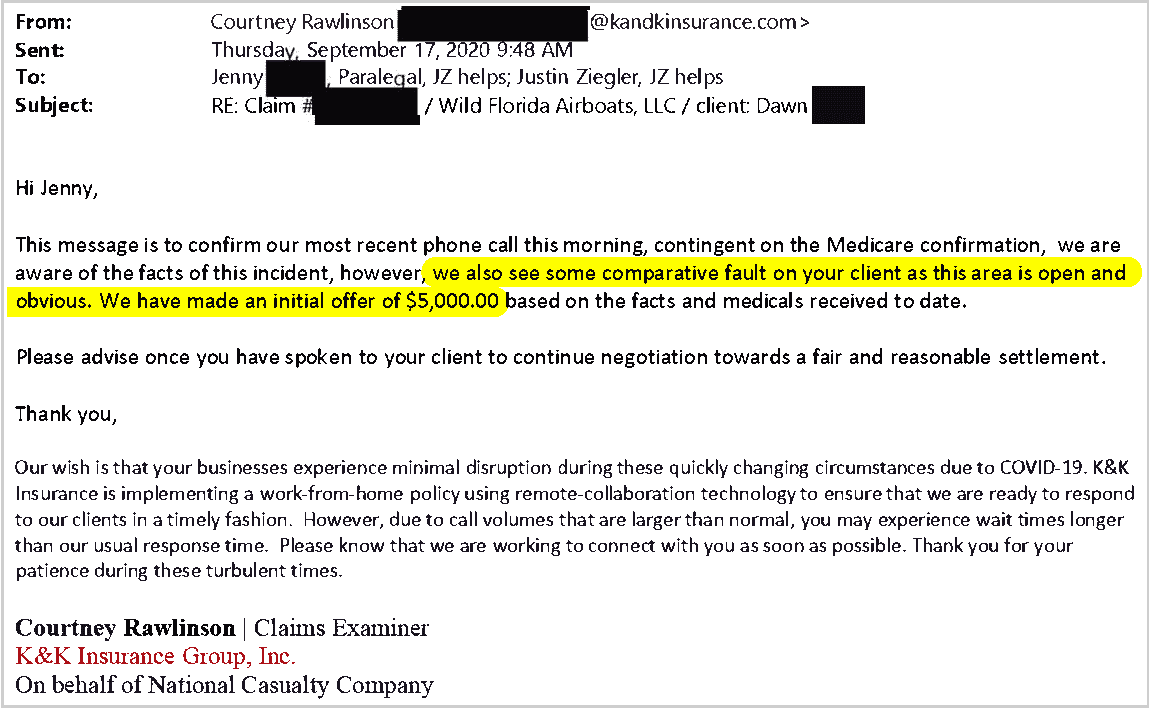
Through aggressive negotiation, I settled Dawn’s personal injury case for $30,000.
You can see the settlement check:

Here is a comparison between the first offer and the settlement:
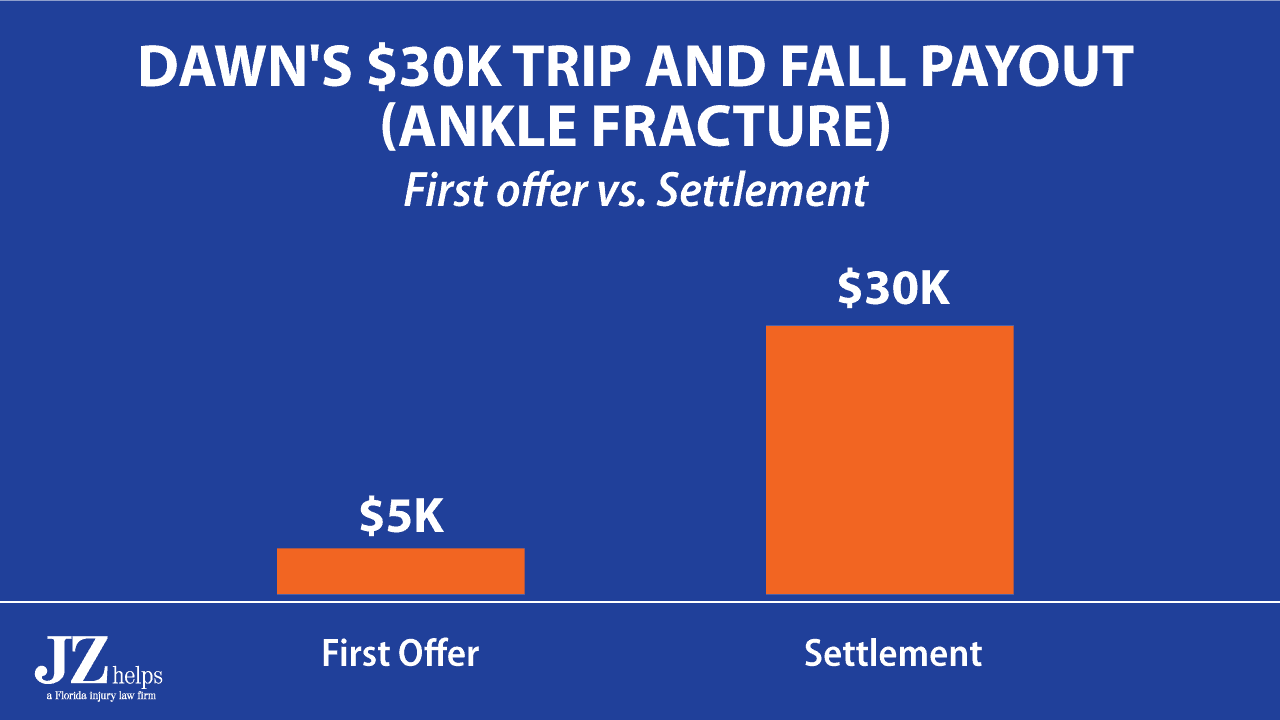
Like most broken ankle cases, most of the settlement was for pain and suffering.
Specifically, I estimate that about 94% of the $30,000 payout was for pain and suffering.
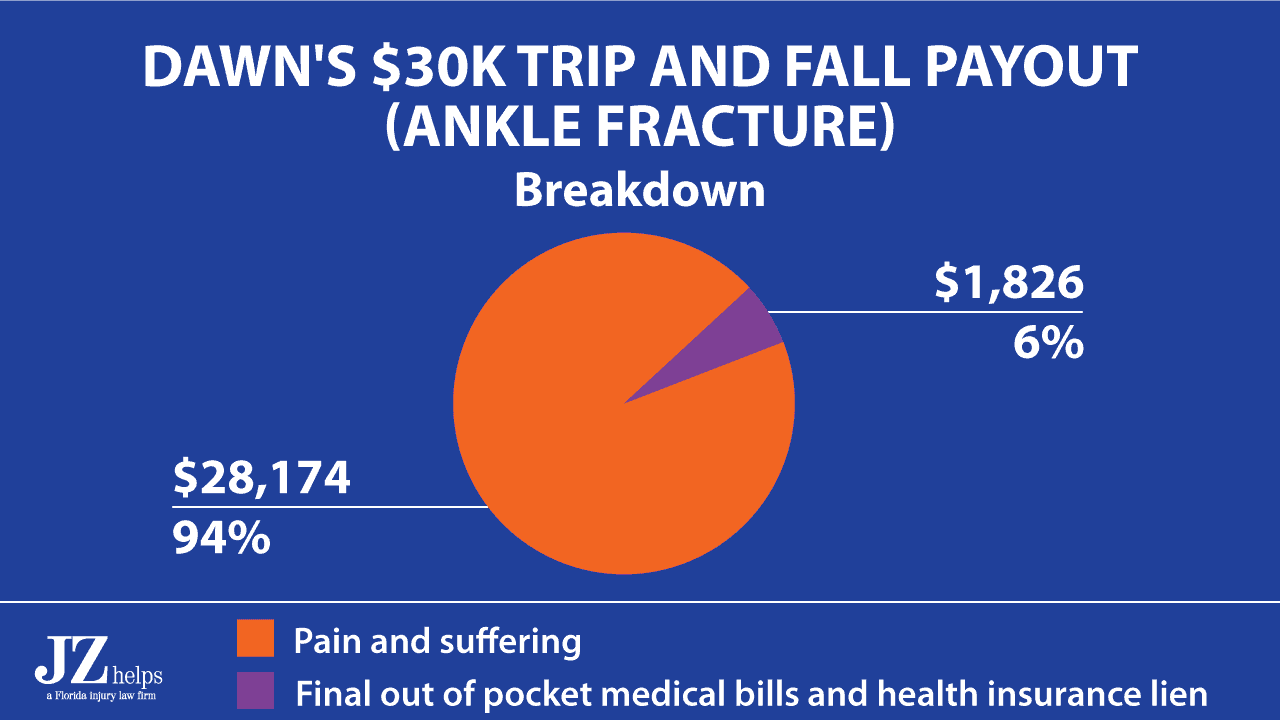
After my lawyer fees, costs and paying the health insurance lien, Dawn got approximately $18,083 in her pocket.
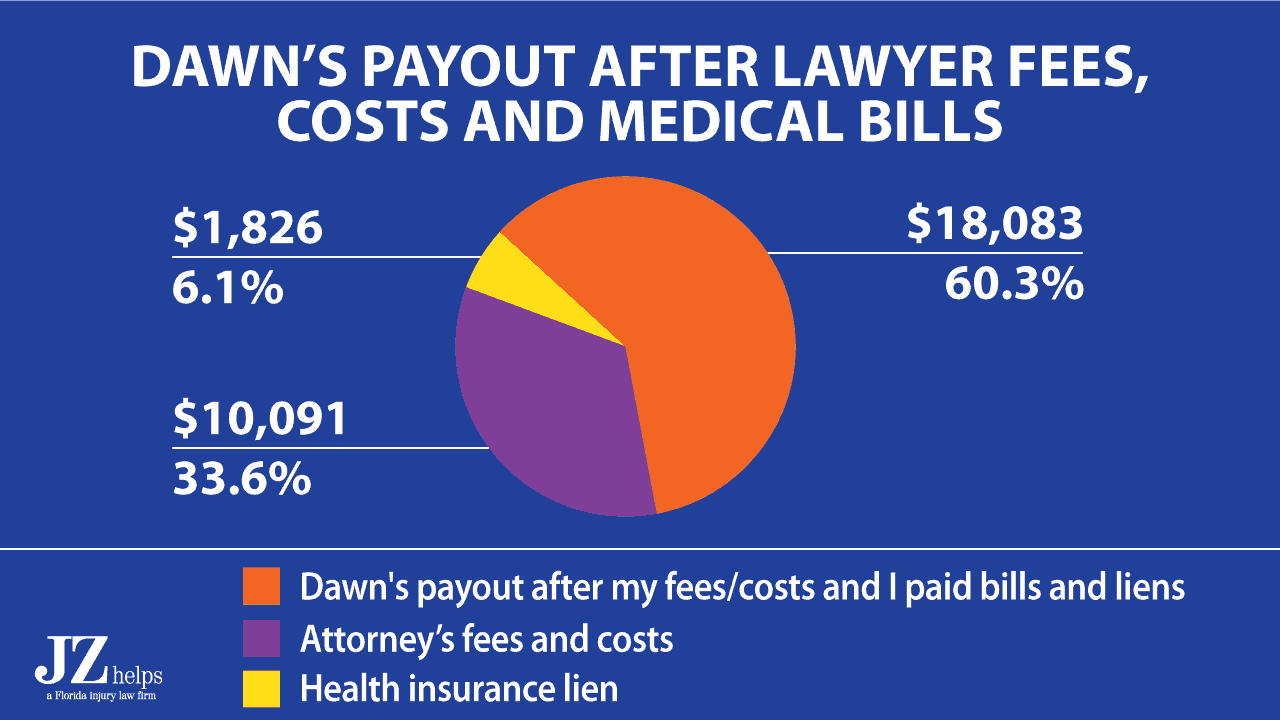
The $30,000 settlement was about 16.4 times the health insurance lien that we had to pay back.
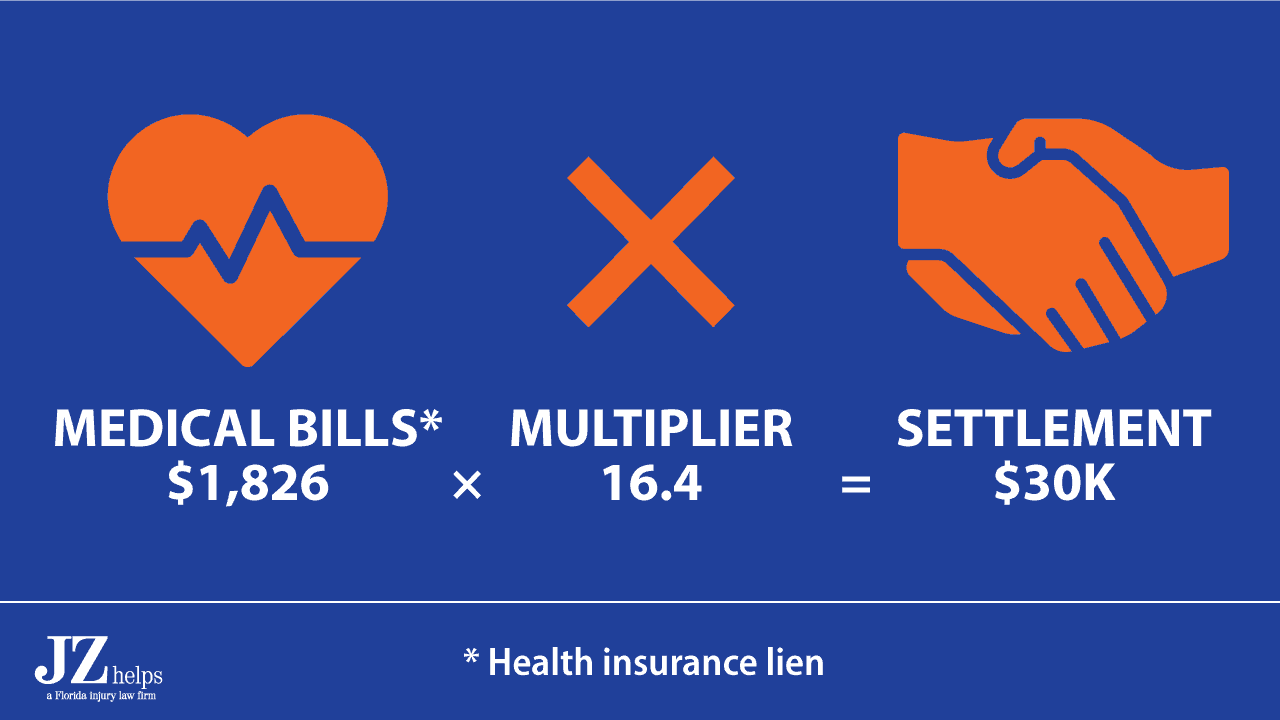
Thus, the pain and suffering multiplier was about 16.4.
How was I able to settle for $30,000 and not a smaller amount?
First, there was something wrong with the pavement that we argued caused her to roll her ankle and fall. Second, the business knew that she fell. This helped her case since it made it more difficult for the business to argue that she was not injured on its property.
Third, she broke her ankle and went to the hospital quickly after the accident. Fourth, we were dealing with one of the better insurance companies. Nationwide Insurance Company generally pays better than other insurance companies.
Why didn’t I settle for more than $30,000?
Because her fall happened outside during broad daylight. The insurance company argued that Dawn should have seen the broken walkway before she fell. In other words, they argued that she should have avoided the broken pavement and not fallen.
If her fall would have happened at night and there was poor lighting, Nationwide would have likely paid us more than $30,000.
Also, Dawn did not need surgery. If she would have had a plate and screws put in her ankle, we would have likely settled for $100,000 or more with Nationwide. This is because the pain and suffering component of the case would have been much larger.
Lady Gets $25K Settlement for Ankle Fracture from Slip and Fall
A woman was walking down stairs. She slipped on water. Thus, she knew that the floor was slippery before her fall. Moments later, she (again) slipped on water. As a result of her second slip (and fall), she broke her ankle.
After the fall, she searched for a slip and fall lawyer in Miami. She got a free consultation with me to see if I could represent her. After we spoke, she hired me as her attorney.
When calculating the settlement value of her case, I estimated that she was at least 50% at fault for not looking where she was walking. My estimation was based on the facts of this particular case.
We settled her case for $25,000. She was happy with the payout.
Target Shopper Gets $60K for Ankle Fracture
This isn’t my case. A shopper got a $60,000 verdict for pain and suffering for a fractured ankle. She claimed that she slipped on a worn out and wet carpet at Target in Miami-Dade County, Florida.
The shopper argued that Target should have fixed the carpet before her fall. She claimed the carpet was a hazard.
Target blamed her for not paying attention where she was walking. Her husband made a claim for loss of consortium, but the jury did not award him money. The verdict was in 2010 and the case is Hernandez v. Target.
My thoughts: Though I am not 100% certain, I think the entire verdict was for pain and suffering.
If so, this verdict is within the range that I use as a starting point for settlement purposes for pain and suffering for an ankle fracture from an accident in Florida caused by someone else.
Many juries give little, if anything, money for a loss of consortium claim if the spouse’s injury is not horrible. This is one of many personal injury verdicts for an accident at Target.
Jury Awards Only $7K for Ankle Fracture (from Fall)
This isn’t my case. A jury awarded $7,000 for an ankle fracture from a shopper’s fall. $2,000 of this verdict was for pain and suffering.
A 71 year old woman who fractured her ankle when she fell down in a Publix parking lot in Palm Beach County, Florida.
She was self-employed in a secretarial business.
What caused her fall?
She claimed that she stepped in a hole (divet) at the corner of a storm drain in the parking lot and fell.
She claimed that Publix was negligent in failing to repair the drain. The jury also awarded about $5,000 for economic damages. The jury found her 50% at fault for the accident. The verdict was in 2003.
My thoughts: The amount awarded for pain and suffering is way below the average settlement value for a broken ankle in an accident in Florida caused by someone else.
The amount that was awarded for pain and suffering will be cut in half (she’ll get $1,000) because she was 50% at fault for probably not paying attention.
This is one of the many verdicts and settlements against Publix in Florida. The case is Lorraine v. Publix Supermarkets.
How Much Is a Trimalleolar Ankle Fracture Worth?
“Tri” means three. Trimalleolar fracture means that all three malleoli of the ankle are broken. These are unstable injuries and they can be associated with a dislocation.
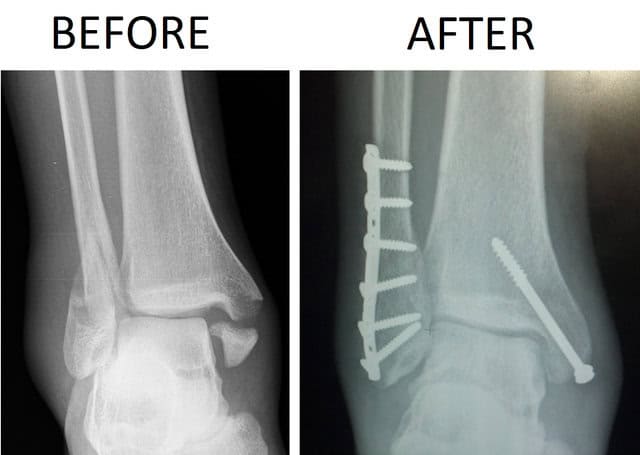
What does a trimalleolar fracture look like before and after surgery?
Past recent Florida jury verdicts put average pain and suffering portion of most trimalleolar fractures with surgery at between $250,000 to $350,000.
The average pain and suffering amount for a trimalleolar fracture is usually towards the middle of that range.
Again, I’m talking about the full value before any reductions for liability or the injured person’s fault.
Surgery for a trimalleolar fracture involves inserting screws and a plate(s). This is known as open reduction internal fixation.
How Does a 2nd Surgery to Remove Hardware Affect a Trimalleolar Case Value?
After you have screws put in your leg to fix your trimalleolar fracture, they may irritate your skin.
If they does, an orthopedic surgeon may later remove a screw(s). At this time, the doctor may also clean out the area, including any ligaments, tendons or muscles.
If you have this hardware removal surgery, after you’ve had hardware inserted to fix your trimalleolar fracture, the full value of the pain and suffering component is higher.
Thus, the 2nd surgery (removing the hardware) adds value. Both surgeries combined are likely worth between $300,000 and $350,000 in pain and suffering assuming you have a big pain reduction and pretty good result. Of course, you need to reduce the value for any factors such as difficulty with proving liability or damages.
$667K Verdict for Trimalleolar Ankle Fracture (With Surgery)
This isn’t my case. On June 20, 2016, Lebron was a passenger on Royal Caribbean’s Adventure of the Seas cruise ship. He was ice skating on this Royal Caribbean cruise ship. Yes, some cruise ships have ice skating rinks onboard.
While skating, fell. He said that the cause of the fall was a groove in the ice, and broken laces on his skates.
As a result of the fall, he suffered a right trimalleolar ankle fracture. About 7 days after his fall, surgery of his right ankle was done. After the operation, he wore an ankle cast for 3 months. He couldn’t put weight on his ankle. Then, he had physical therapy.
His personal injury lawyer hired an orthopedic doctor Brad Cohen, M.D. to do a one time exam of him, review all of the medical records, and write a detailed report. (Sadly, this doctor died in the Miami condo collapse).
He continued to complain of right ankle pain, stiffness and decreased sensation on the top of his foot. He had difficulty with prolonged walking, especially uphill.
His ankle pain was improving. However, his ankle was tender to touch. He experienced sharp, aching and associated with swelling and limited range of motion.
On a bad day, his pain was 8 out of 10. When his attorney hired a doctor to examine him, his pain was 6 out of 10 currently.
He has been treated with anti-inflammatory medications, and Cataflam. Cataflam is used to relieve pain and swelling (inflammation) from various mild to moderate painful conditions.
He did not have any injuries to his right ankle before the fall.
On October 2, 2018, a jury awarded him $625,000 for his pain and suffering. That is a very good pain and suffering award.
They also awarded him $42,005 for his medical bills. Therefore, the total verdict was for about $667,000.
However, the only found the cruise line 65% responsible. Thus, he is only entitled to 65% of the verdict.
The jury could have easily found that the cruise line did nothing wrong. This is a big win for the passenger.
This is a good verdict to send to an insurance company if you have a trimalleolar ankle fracture with surgery.
If you send the appellate opinion to the insurance adjuster, you may also want to send the independent medical evaluation from this case. This shows the adjuster the exact injuries that led to that verdict.
That evaluation is important because insurance adjusters like to argue that every case is different. While this is true, you want to show them verdicts of injuries that are similar to yours.
That evaluation is also important because you can compare the seriousness of your trimalleolar fracture (with surgery) with Lebron’s.
Even if you have an ankle fracture with ORIF surgery, but it’s not a trimalleolar fracture, you can still send this verdict to the insurance adjuster in your case. It’s the only ankle fracture with surgery that I can find a verdict or settlement for from August 2018 through August 2021.
$1.63 Million for Trimalleolar Fracture from Fall at Wendy’s
This is not my case. $1,600,000 of the settlement was for pain and suffering. She had a trimalleolar fracture.
A doctor put a plate and 4 screws inserted (open reduction internal fixation). She had a separate surgery to remove the plate and screws.
Her ankle was in a cast for 6 weeks and she used a wheelchair during that time.
She allegedly slipped and fell in a depression (hole) on a restaurant’s property. She claimed the depression was caused by vehicles driving through the area. The case is Armstrong v. Wendy’s. The settlement was in 2007.
As you can see from the above result, there have been verdicts in a Florida personal injury case that are above $1 Million dollars for a trimalleolar fracture with surgery. However, most settlements are generally not for this amount.
As in any personal injury case, if the injured person is likeable then he or she has a better chance of getting closer to the higher end of this range.
The more that one’s activities of daily living are limited, then the greater the chance that he or she may get a settlement toward the higher end of the above range.
Therefore, someone who has difficulty walking (with a limp or otherwise) will generally have a greater pain and suffering component to his or her claim than someone who can walk much better.
$75,200 Verdict for Ankle Fracture from Slip and Fall
This is not my case. A 55-year-old woman who slipped and fell at an apartment complex in Miami-Dade County, Florida. $70,000 of the verdict was for pain and suffering.
The appeals court affirmed (approved) it. She was also awarded approximately $5,200 for medical expenses.
She fractured all three ankle bones, which is called a trimalleolar fracture.
It gets worse.
She was hospitalized for ten days and was in a full leg cast for six weeks. As a result, she could not care for her disabled husband. The doctor gave her a 10% disability of the ankle, and she had continued pain, muscle atrophy, swelling, and a limp. Also, she was unable to walk long distances.
She was expected to live 24.3 years so she was awarded $3,000 per year for the rest of her life. This comes out to $7.00 to $8.00 a day.
The appellate court stated that it could not say that the verdict exceeded the limits of the reasonable. The jury awarded her husband $10,000 on his derivative claim. Malpass v. Highlands Ins. Co., 387 So.2d 1042 (Fla. App. 3 Dist., 1980)
My opinion: In 1980, $70,000 was a reasonable amount for pain and suffering for a trimalleolar fracture in a case with similar facts. This was a very severe ankle fracture for her to spend 10 days in the hospital immediately following the injury.
Settlements for Tibia and Fibula Fractures in Children
Sometimes a tibia or fibula fracture in a child involves the fracture of the growth plate. The growth plate is called the physis. It located at each end of the tibia.
If the growth plate is fractured, this increases the full value of the case.
Distal tibial fractures occur at the ankle end of the tibia. They are also called tibial plafond fractures.
One of the common types in children is the distal tibial metaphyseal fracture. This is a fracture in the metaphysis, the part of tibia before it reaches its widest point.
These fractures are usually transverse (across) or oblique (slanted) breaks in the bone.
Distal tibial metaphyseal fractures usually heal well after setting them without surgery and applying a cast.
However, there is a risk of full or partial early closure of the growth plate. This may lead to a growth arrest in the form of leg length discrepancy or other deformity.
Ask the doctor if there is full or partial early closure of the growth plate. If he or she says yes, this increases the full value of the case.
Having one leg longer than the other increases the child’s injury case.
Which Accidents (that Cause an Ankle Fracture) Result in the Biggest Settlements?
Often times, in ankle fracture cases, there isn’t enough insurance to pay for the fair value of the claim. However, there is often plenty of insurance if the accident involves an Uber or Lyft car.
Therefore, Uber accident settlements and Lyft claims for a broken ankle are likely higher than many other car accident cases.
This is because Uber and Lyft drivers are often covered with big bodily injury liability (BIL) insurance policies.
On the other hand, many motorcycle accident settlements for ankle fractures may be smaller because many drivers carry very little car insurance coverage. And there is often no uninsured motorist insurance on the motorcycle.
The same is true for a pedestrian who is hit by a car. Often times, the at fault driver has limited BIL insurance. This can leave the pedestrian with the possibility of getting a smaller settlement.
Which Doctors Won’t Kill an Ankle Fracture Case?
It’s important to hire a good lawyer for an ankle fracture case. However, it’s just as important to get treatment from a doctor who won’t destroy your ankle injury claim. Doctors who are likely to hurt the injured person’s case are called “defense doctors”.
Remember:
Your medical records are the heart of your ankle injury case. Sloppy medical records can hurt the value of a case. This can mean a smaller settlement offer.
How can the wrong doctor kill your case?
For starters, an unhelpful doctor won’t conference with the injured person’s lawyer. This is bad because you need to know what the doctor will say if the case winds up in a lawsuit. You don’t want to spend the money (and time) filing a lawsuit only to later learn that your doctor will sink your case.
Moreover, a defense doctor’s initial patient questionnaire might not ask you if you were injured in an accident. Thus, an unhelpful doctor may not mention the accident in his medical records. I’ve had this happen before. Trust me, it’s no fun. And if the medical records don’t mention the accident, chances are that the doctor didn’t bill the proper insurance(s).
It gets worse. An defense doctor may say that your ankle is perfectly fine even if you have pain or other doctors believe it’s a permanent injury.
Some defense doctors earn big money testifying for insurance companies. These defense experts can earn hundreds of thousands of dollars a year.
Don’t panic. There is hope.
There are other doctors who will give you fair shake. These doctors are “patient advocates”. They don’t earn the majority of their expert income from insurance companies.
In a moment, I’ll share the names and contact information for some orthopedic doctors and podiatrists who are known for being fair to injured accident victims.
One of the benefits to hiring a personal injury lawyer is that he or she can tell you if your foot doctor will destroy your case. If so, the attorney should be able to give you the names of an orthopedic doctor or podiatrist who is fair.
Additionally, an accident attorney can ask your doctor the proper questions so that their medical report accurately documents your injury. After all, in order to get a fair settlement for your injury, you need a detailed medical records.
Below is my list of Miami and Broward County doctors who have a reputation for being fair to injured accident victims. My list contains the names of South Florida ankle doctors.
However, I have other lists for the entire state of Florida. This is because I represent people throughout the entire state of Florida.
Miami-Dade County Foot and Ankle Doctors
- Michael R Cook, DPM Phone (305) 412-1218 8955 SW 87th Ct #108, Miami, FL 33176
- Dr. Jesse Shaw, DO (Hialeah) , Hollywood and Pembroke Pines)
- Dominic J. Lewis (Aventura, Florida) Phone 305-937-1999
- Dr Allison Guyen (Miami Beach)
Broward County Foot and Ankle Doctors
- Steven M. Spinner, DPM, 201 N University Dr #110, Plantation, Florida 33324(954) 370-2400
- Steven D. Steinlauf, MD (Orthopedic Foot and Ankle Institute of South Florida) Phone: (954) 961-3500
- Dr. Jesse Shaw, DO (Hollywood and Pembroke Pines)
- Dr. Robert Mills (at Holy Cross in Fort Lauderdale)
Anatomy of the Ankle
3 bones form the ankle joint. They are the:
- Tibia (shinbone)
- Fibula (tinier bone of the lower leg)
- Talus (tiny bone that is between the calcaneus (heel bone) and the tibia and fibula
The tibia and fibula have unique parts that form the ankle. They are:
- Posterior malleolus – the back of the tibia
- Medial malleolus – the inside part of the tibia
- Lateral malleolus – the end of the fibula
The doctor will describe your ankle fracture based on the part of the bone that is fractured. For instance, a break at the bottom of the fibula is known as a lateral malleolus fracture.
Ankle Joints
There are 2 joints that are involved in a fractured ankle. They are:
- Ankle joint – where the tibia, fibula and talus meet
- Syndesmosis joint – the joint in the middle of the tibia and fibula, which ligaments hold together.
There are several ligaments that help keep the ankle joint stable.
Documenting Your Ankle Injury
If you have swelling or bruising, you should immediately take good quality photos of it. This will allow the adjuster to see, at least some of, your injury.
Signs of an Ankle Fracture
A bad ankle sprain can feel just like a broken ankle. Thus, all ankle injuries should be looked at by a doctor.
In addition, the quicker that you get treatment, the better it is for your case. This is because it weakens the insurance company’s defense that your ankle fracture wasn’t caused by the accident.
How Your Doctor Visits Affect Your Case
The doctor will ask you for your medical history, what you’re experiencing and how the injury happened. It is important to choose your words carefully when telling the doctor how the accident happened.
The doctor will describe how the injury occurred in his notes. This will become evidence in your case.
X-rays
X-rays are the most customary imaging technique to see if you have an ankle fracture. They can show if your bone is fractured.
They can also show if you have displacement (gap in the middle of the broken bone). Your case may be worth more if you have a decent size gap between the bone. The bigger the gap, the greater the case value.
The x-rays can also show if there are more than one piece of broken bone. The more pieces of broken bone, the greater the case value.
CT scan
If your fracture goes into the ankle joint, a CT scan can help see the injury. Cases are typically worth more if the fracture extends into the ankle joint.
MRI
An MRI will show both the bones and the soft tissues, such as ligaments.
How Treatment for a Lateral Malleolus Fracture Affects Your Case
A lateral malleolus fracture is a fractured fibula.
Nonsurgical Care
You may not need surgery, if your ankle is stable (broken bone isn’t out of place or hardly out of place). If you don’t need surgery, your case has a lower value.
The doctor may recommend that you wear a short leg cast or high top tennis sneaker. Sometimes, your doctor will let you place weight on their leg immediately. These cases generally have a smaller settlement value because you’re less limited in your activities.
Other doctors may make you wait about 6 weeks to put weight on it.
You’ll usually have to go to your doctor often to get more ankle x-rays. This is to be certain that the fragments of your fracture haven’t shifted out of place during your recovery.
Each time that you see the doctor, this increases your total medical billed charges and out of pocket medical charges. Thus, the full value of the case increases each time you see the doctor.
If the fragments of your fracture have moved out of place, and you didn’t do something carelessly to cause it, the initial responsible party is on the hook for your damages.
Did You Break Your Ankle in an Accident in Florida?
Call me now at (888) 594-3577 to find out for FREE if we can represent you. We answer calls 24 hours a day, 7 days a week, 365 days a year.
No Fees or Costs if I Do Not Get You Money
We speak Spanish. Learn more about us. Check out my law firm reviews.

Leave a Reply